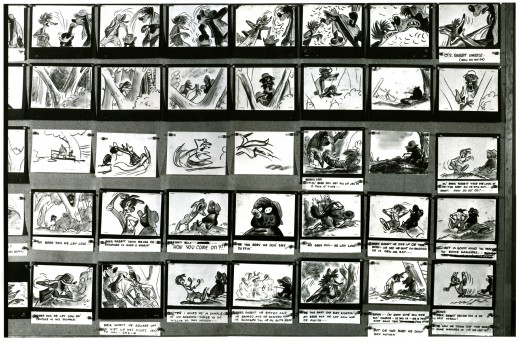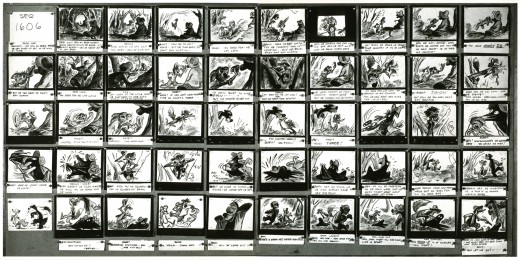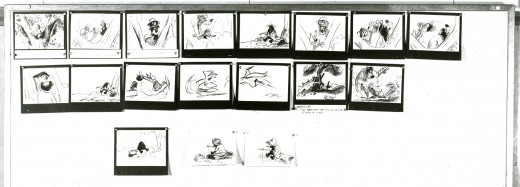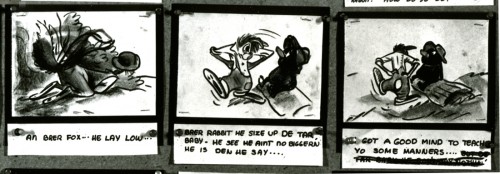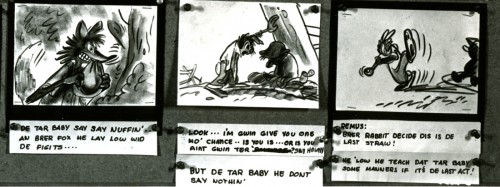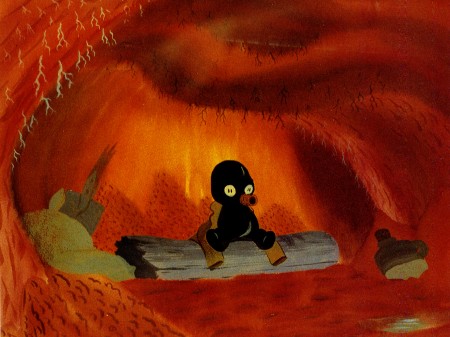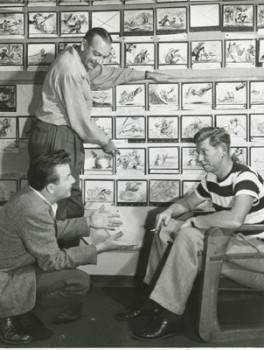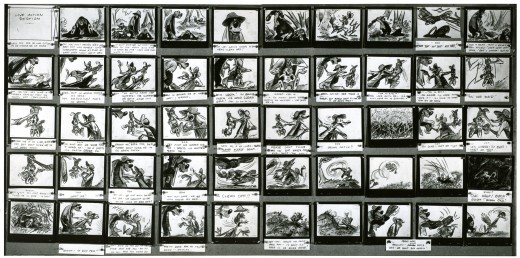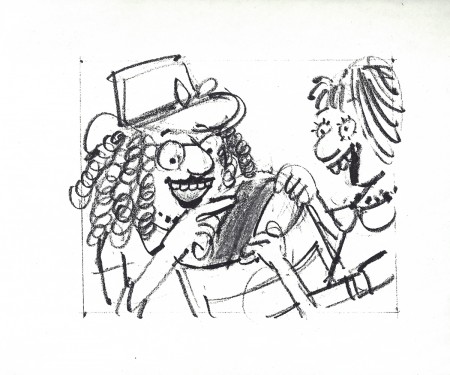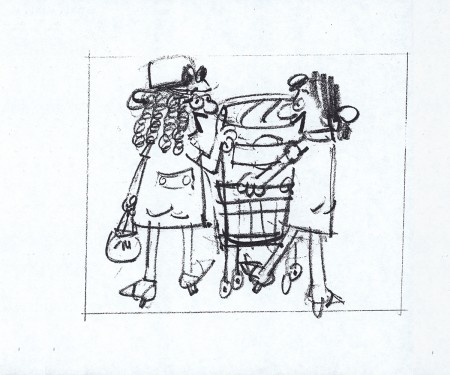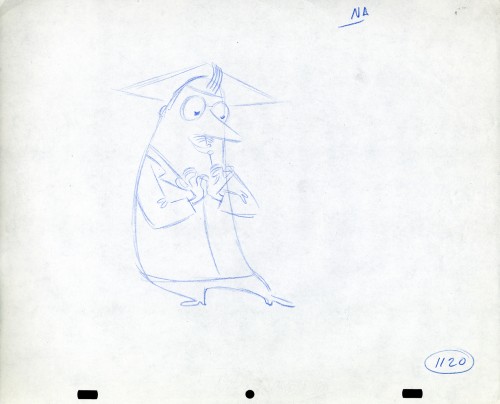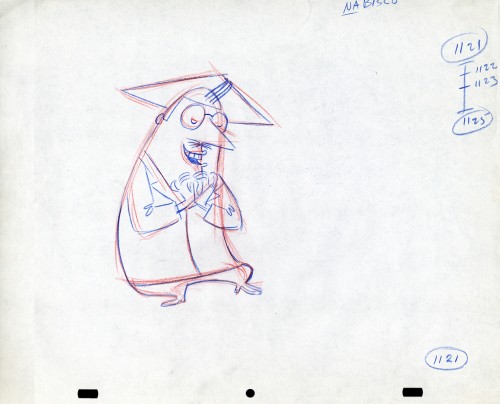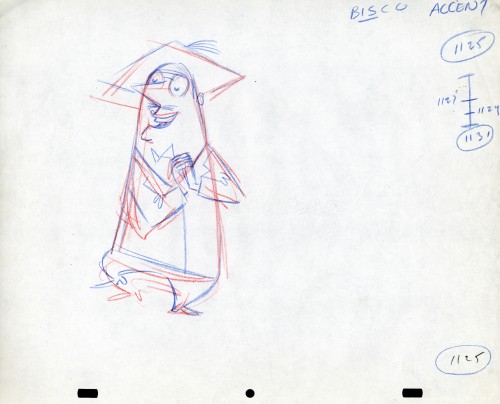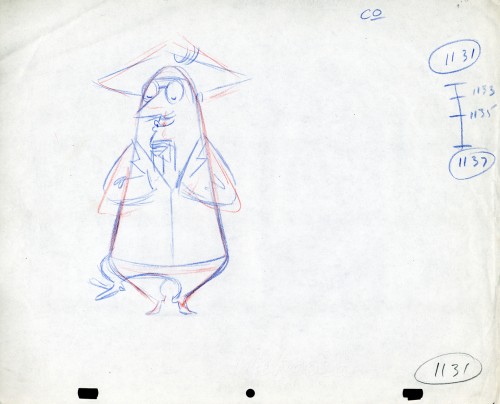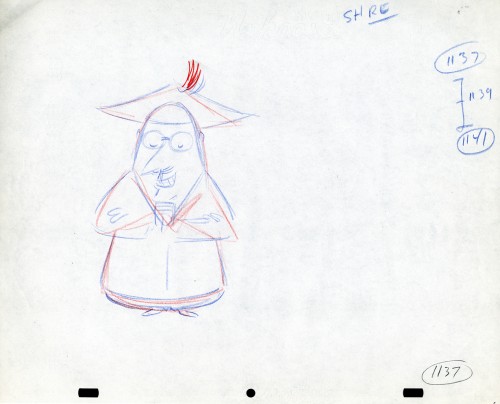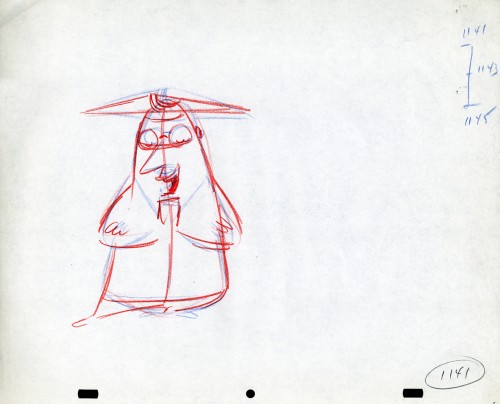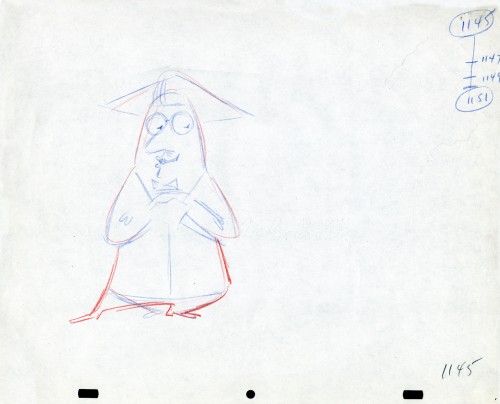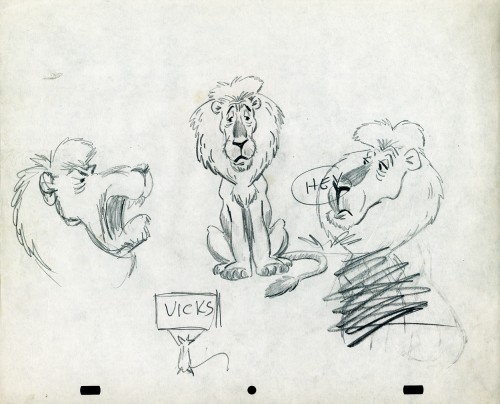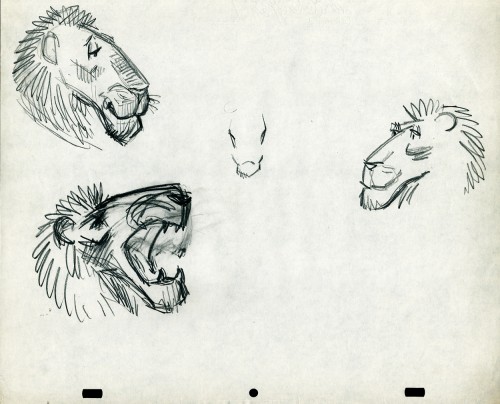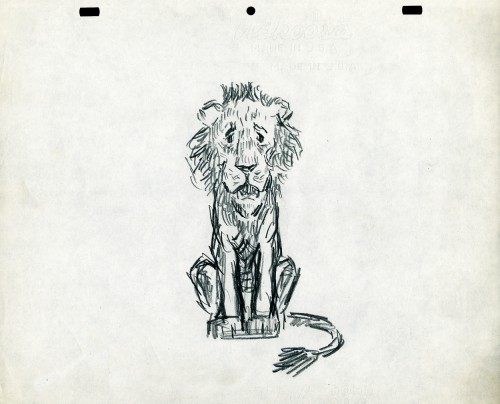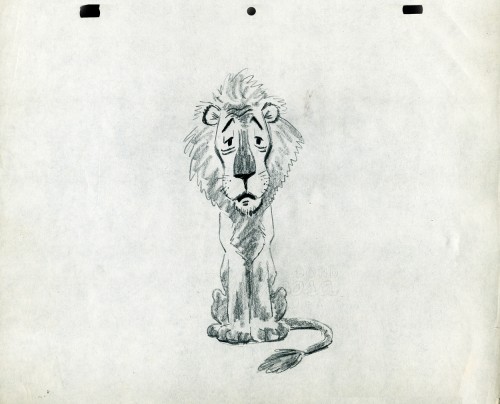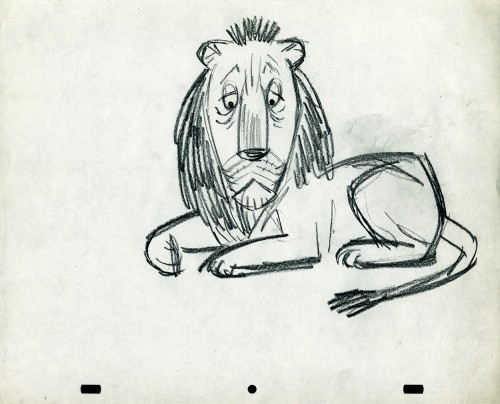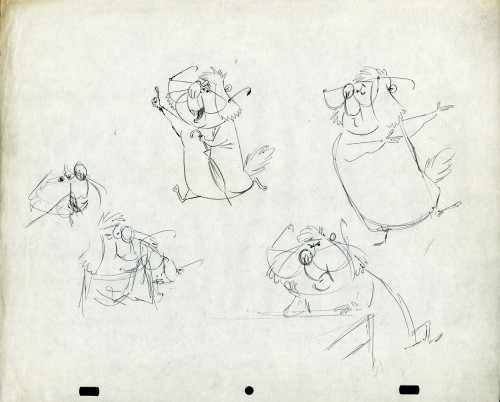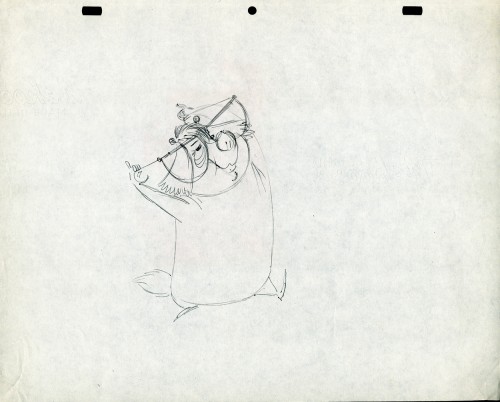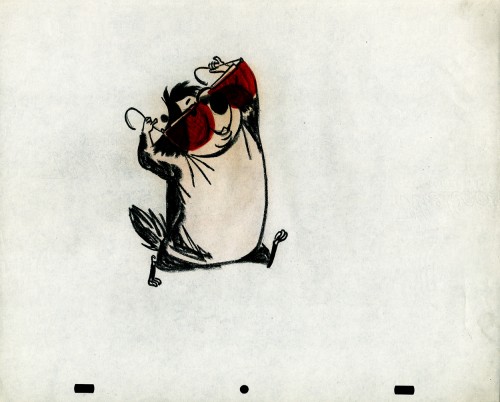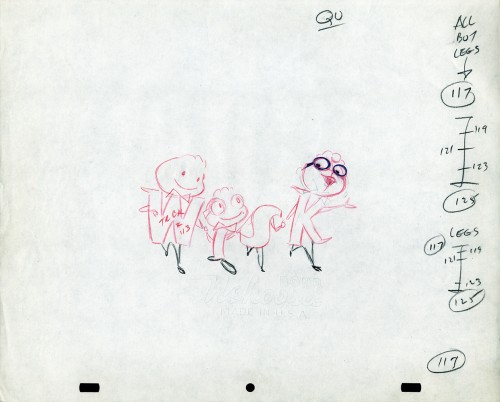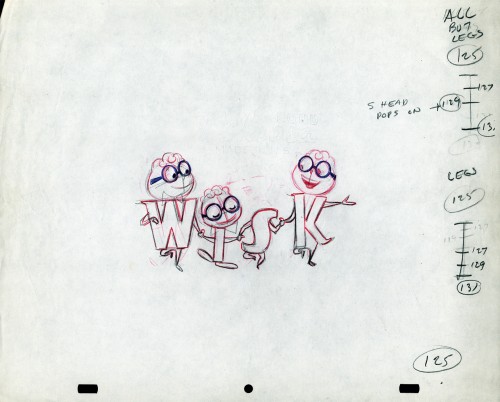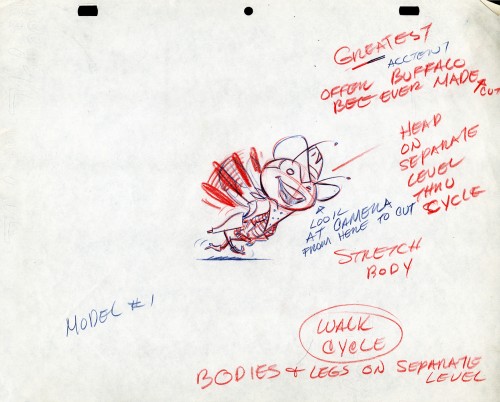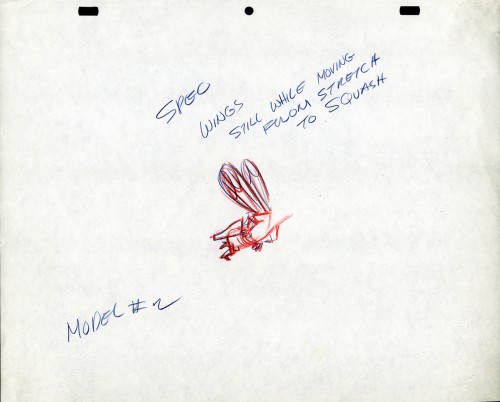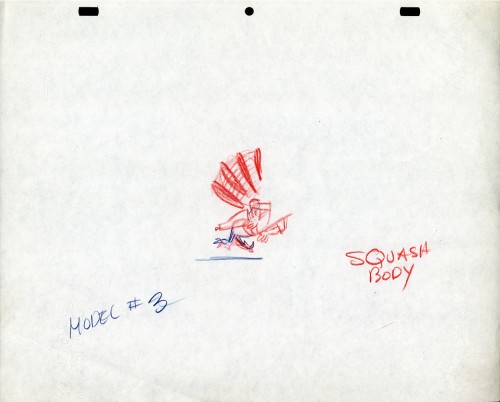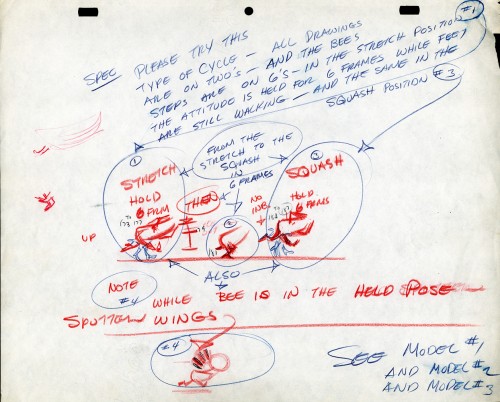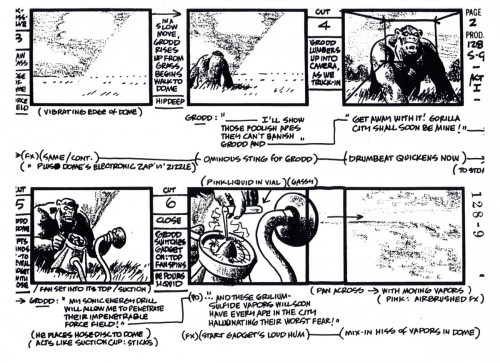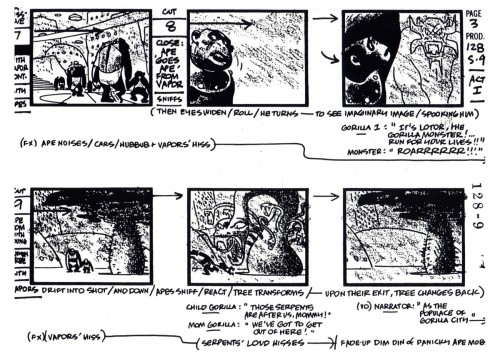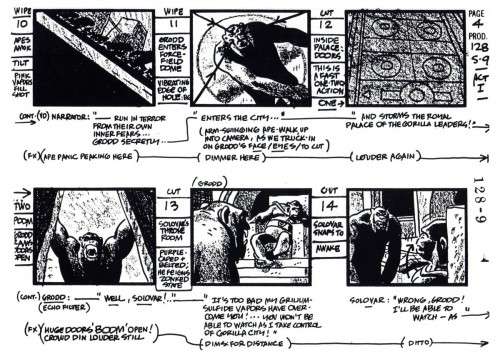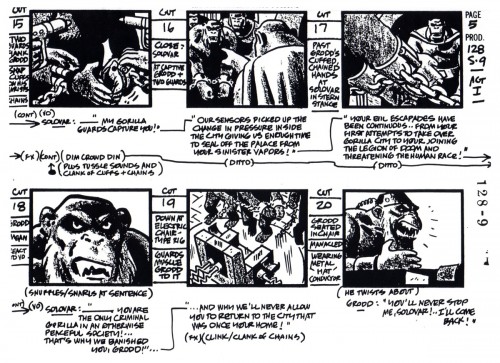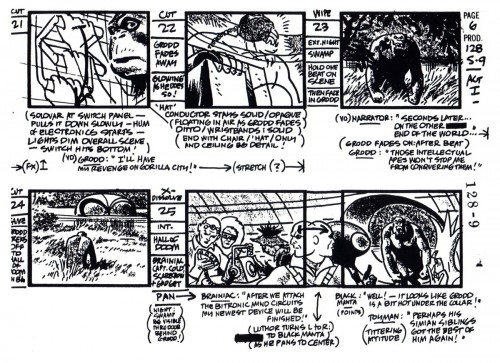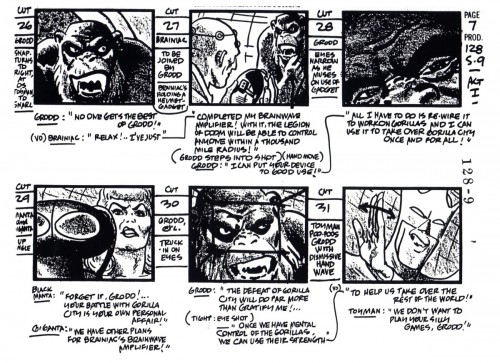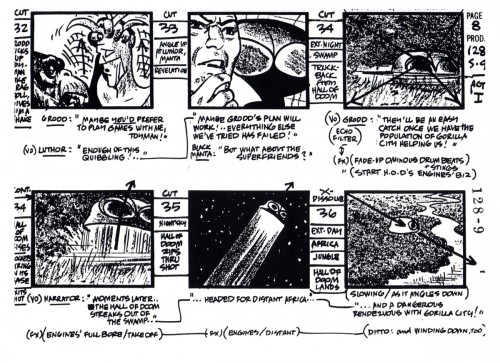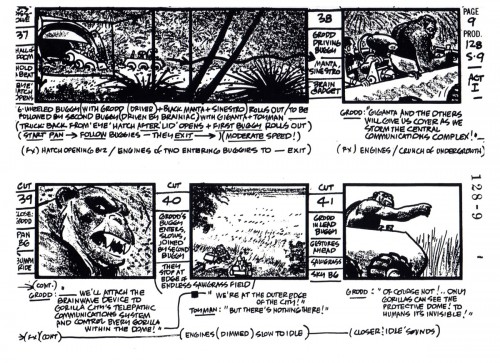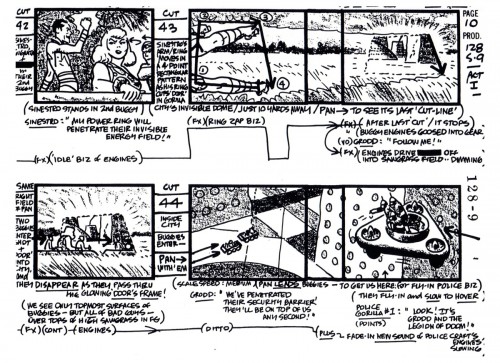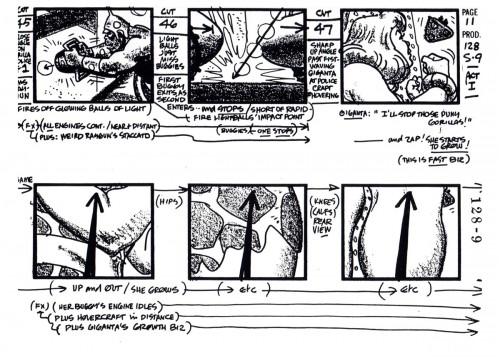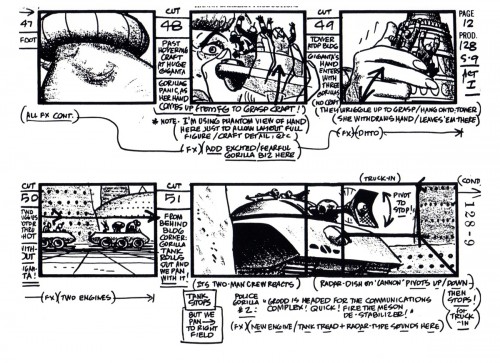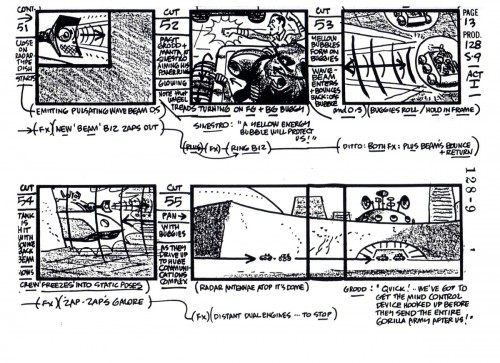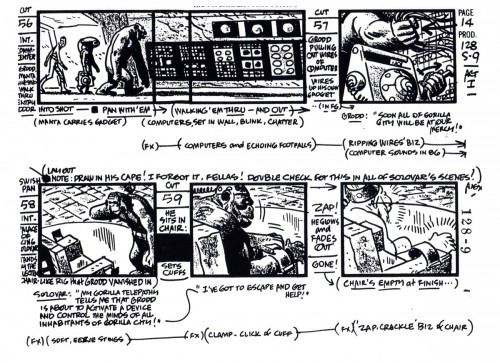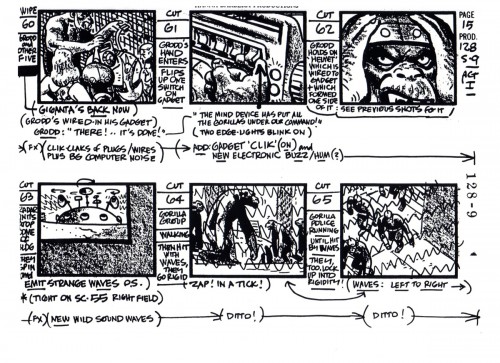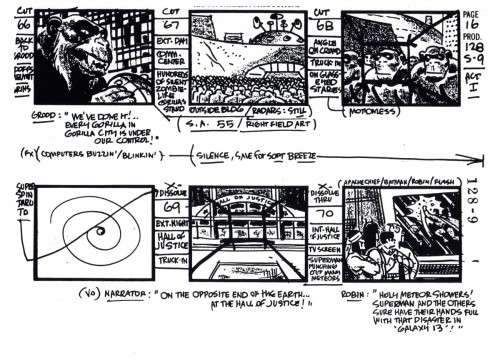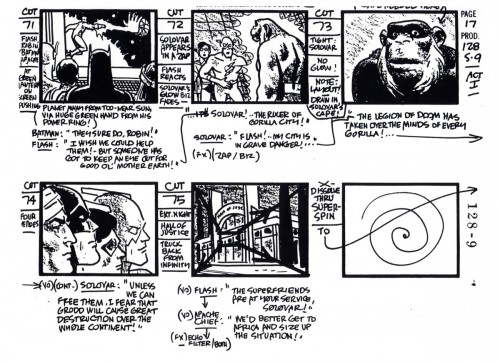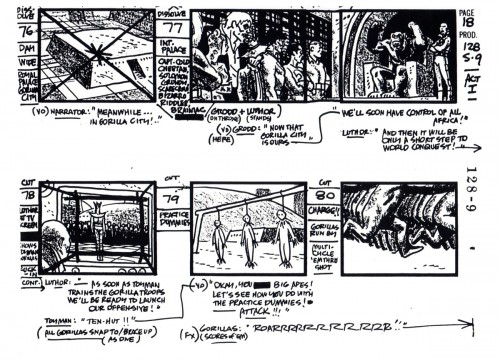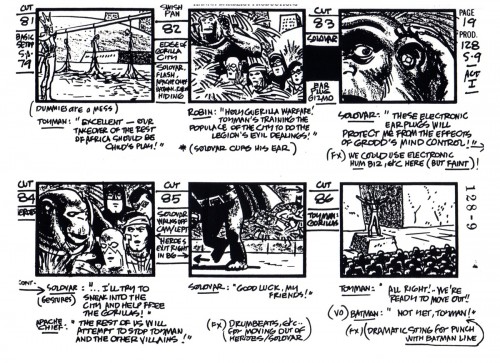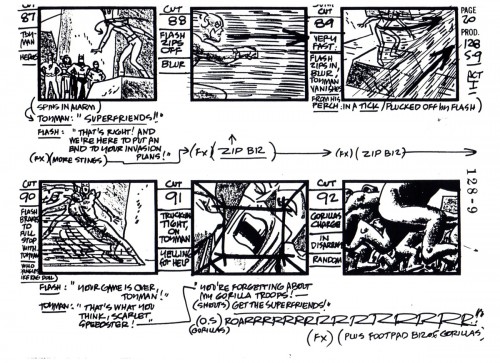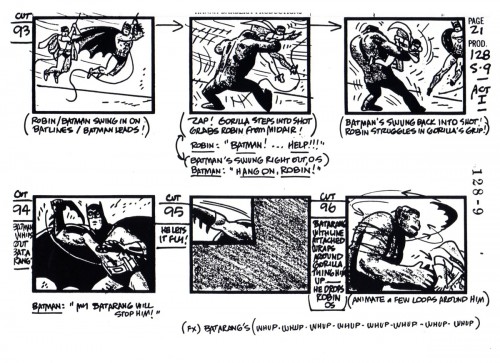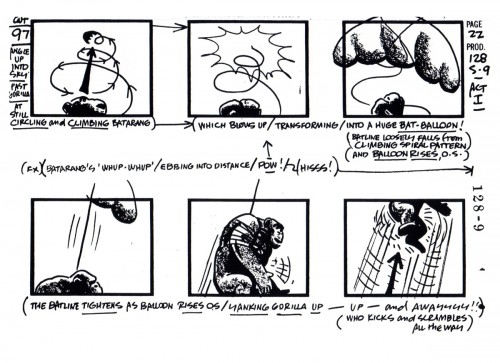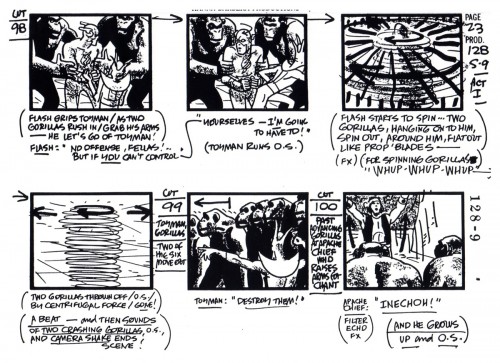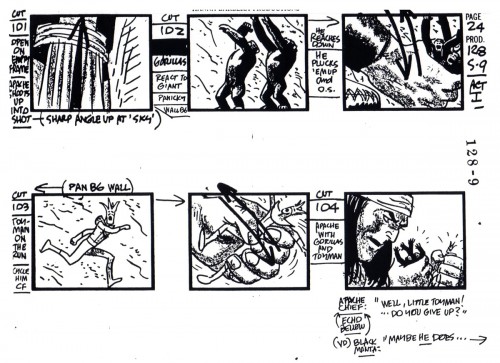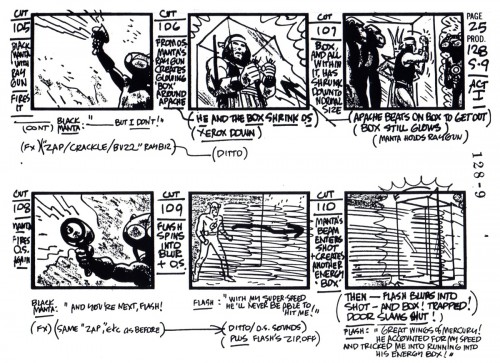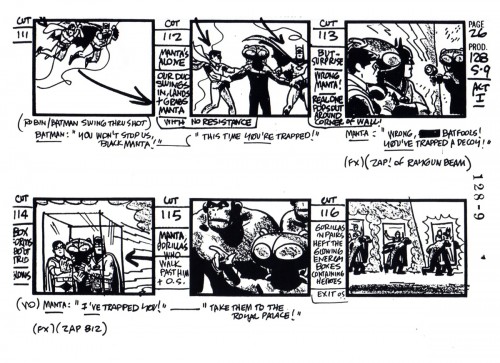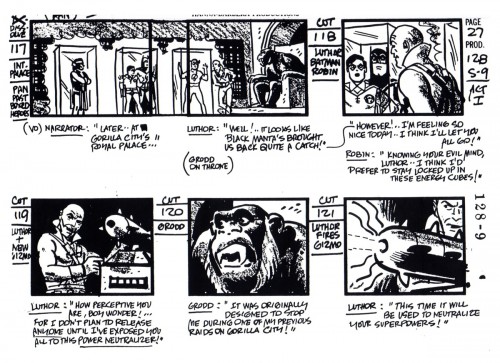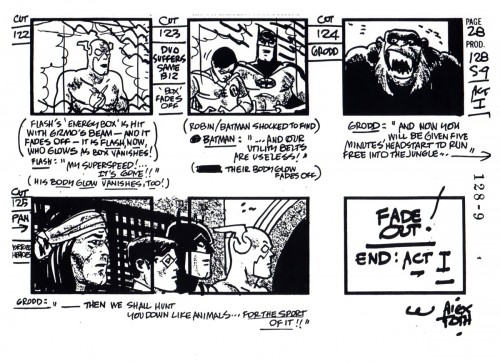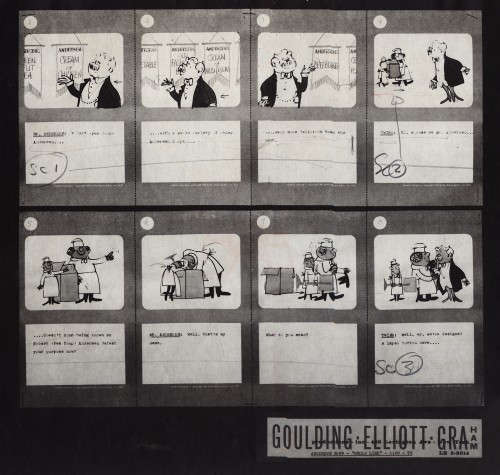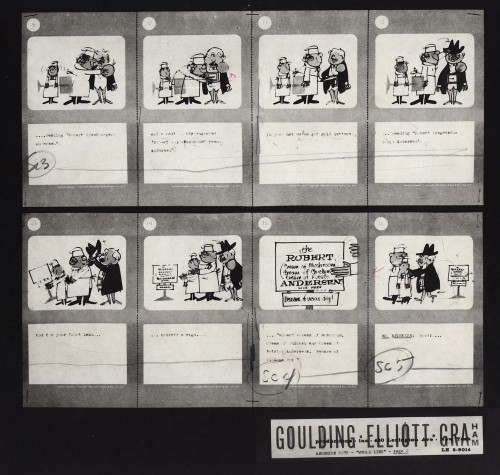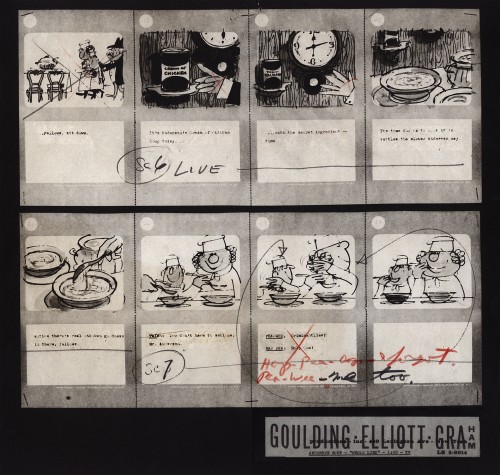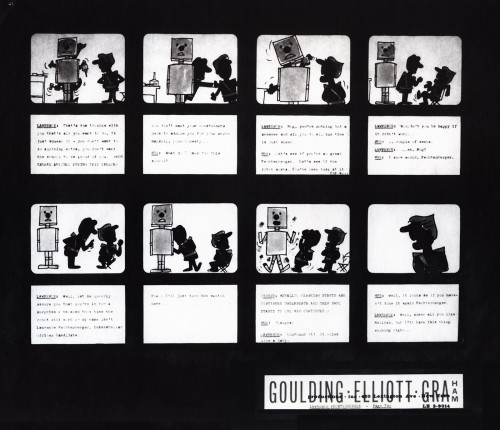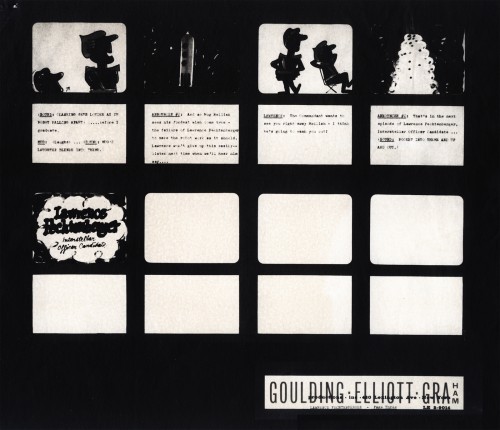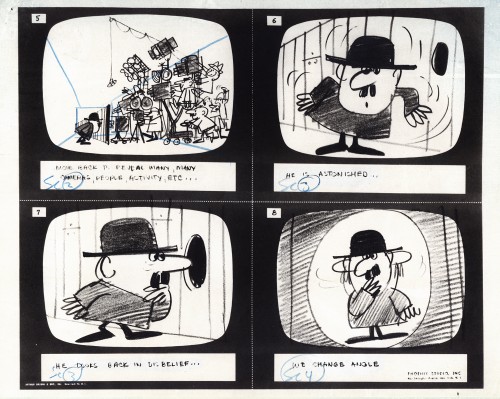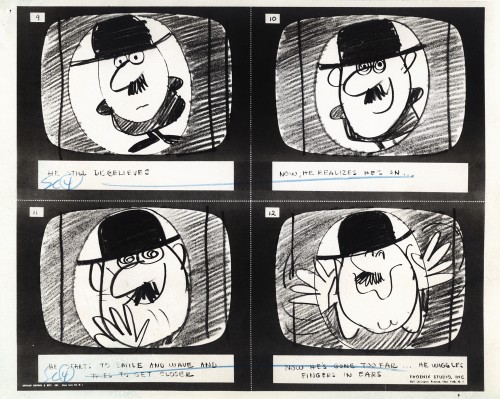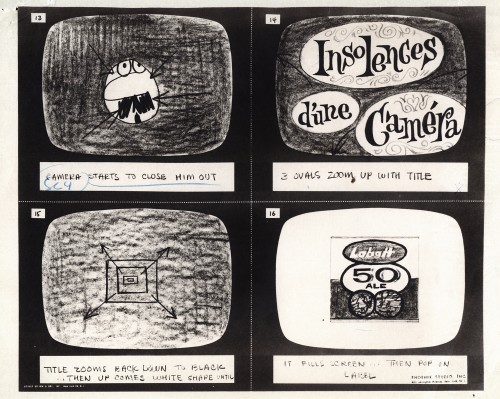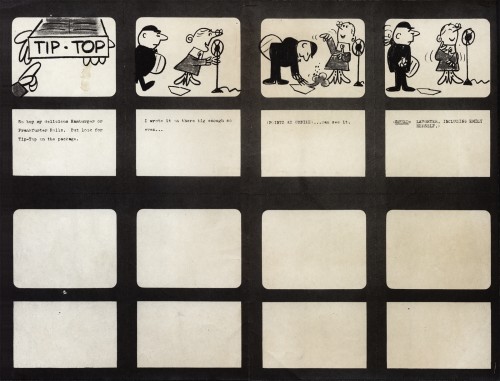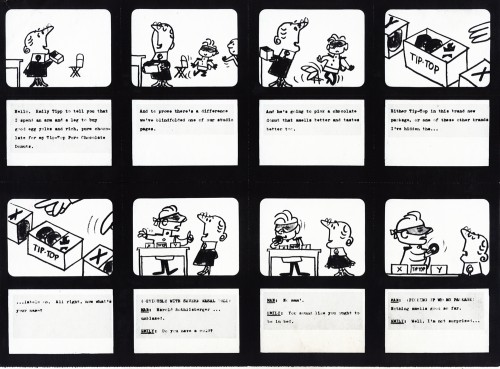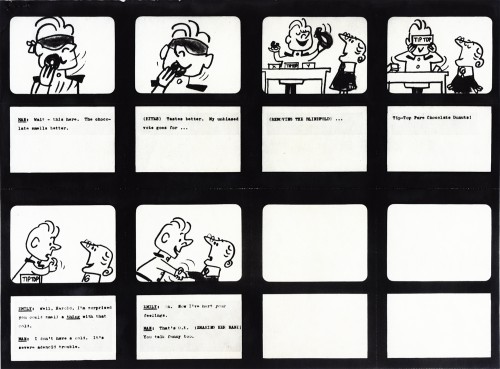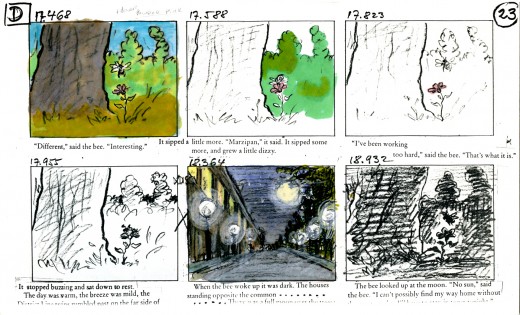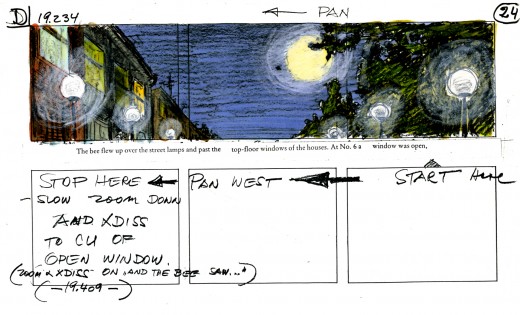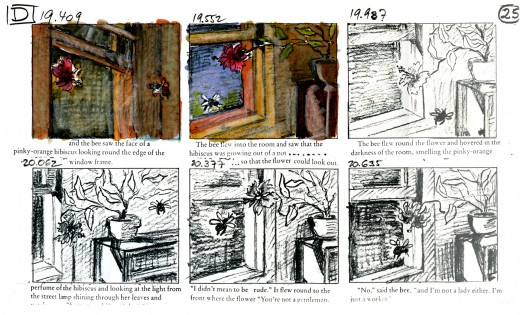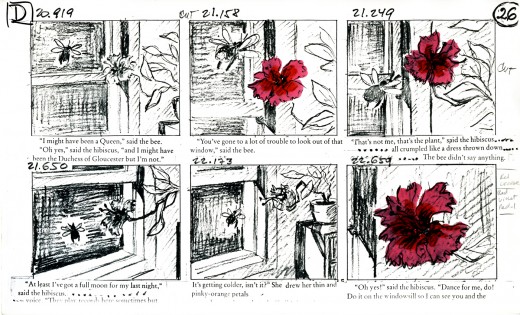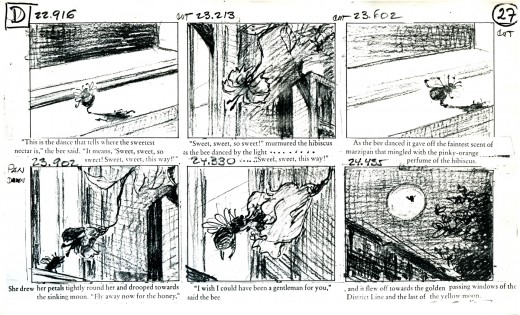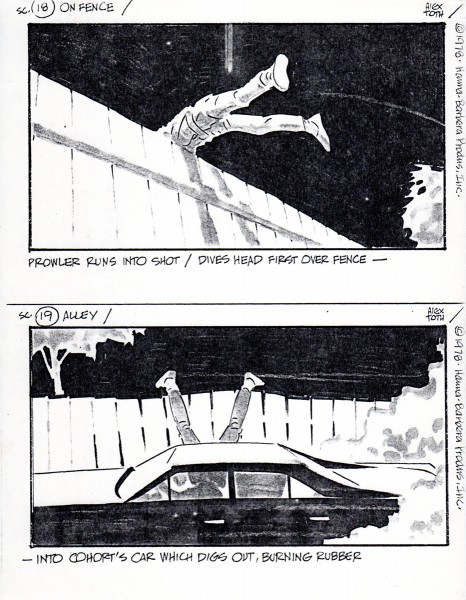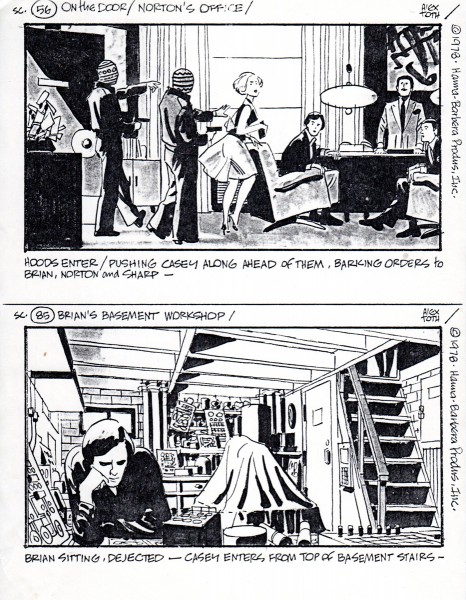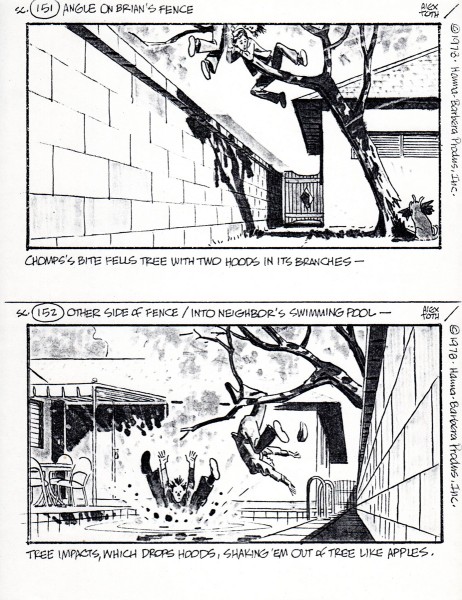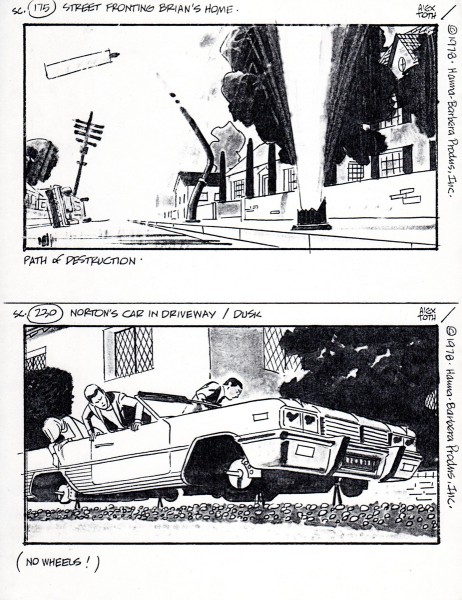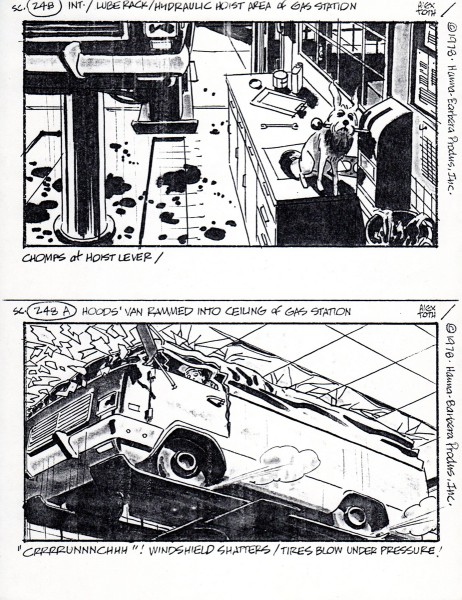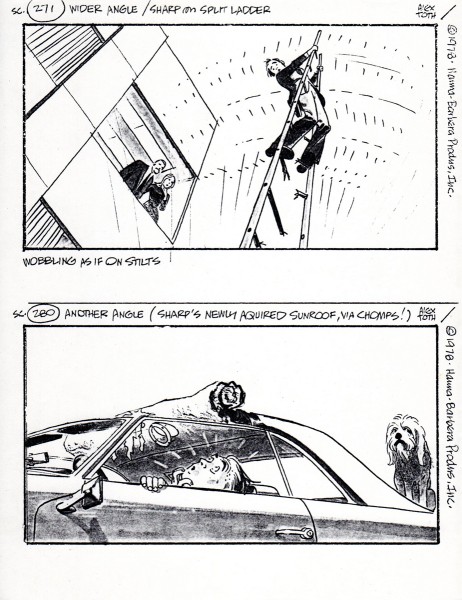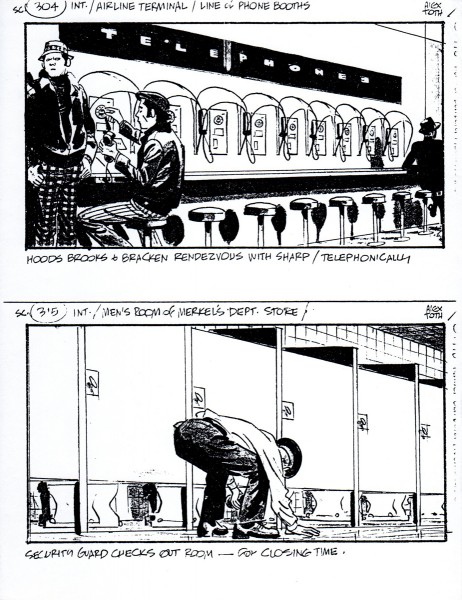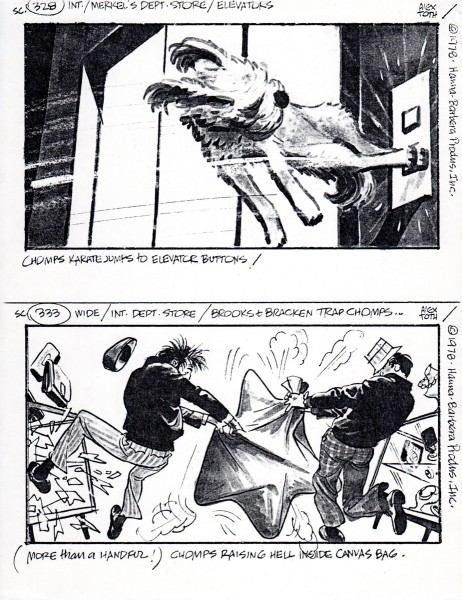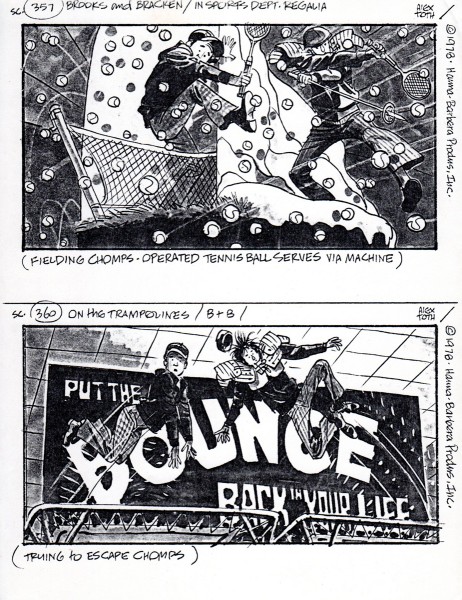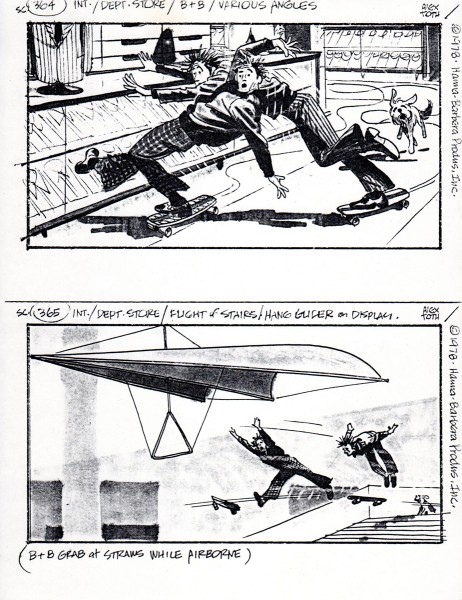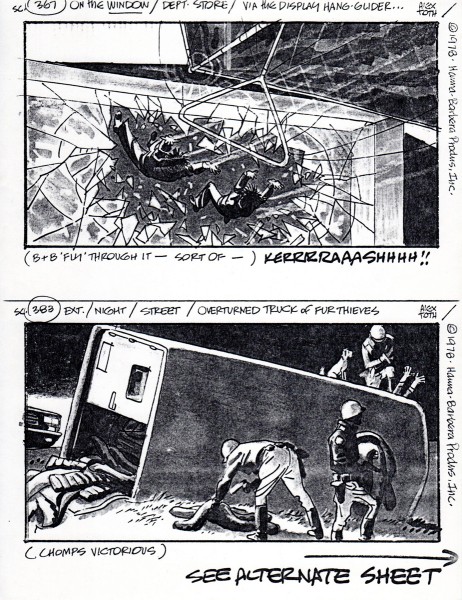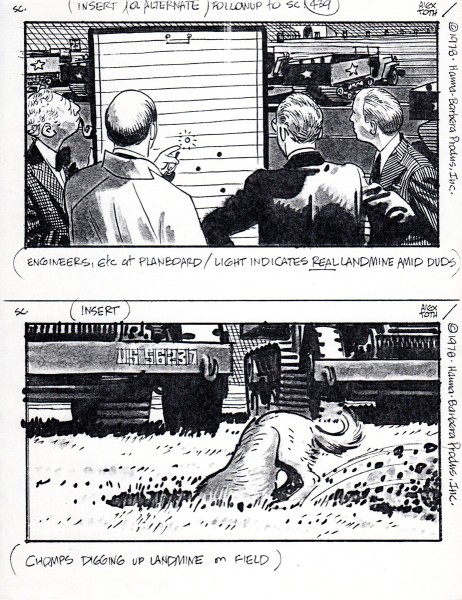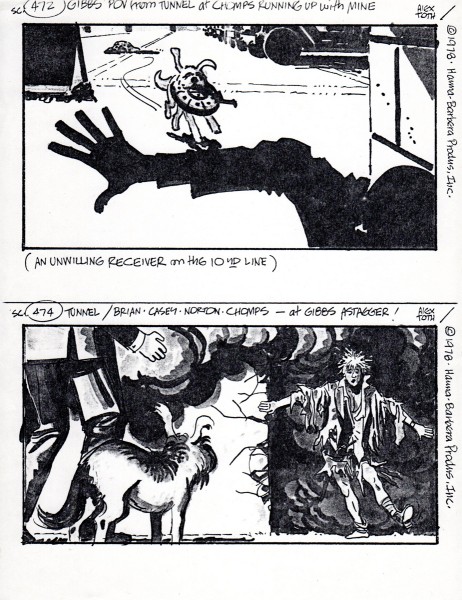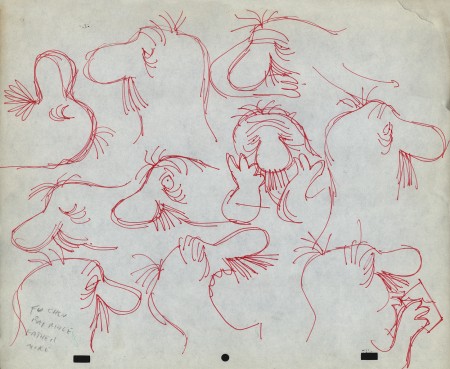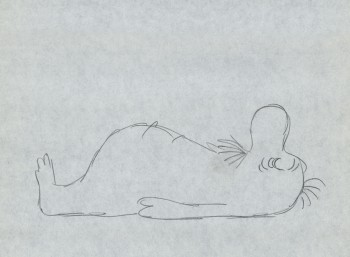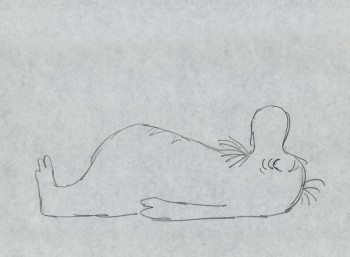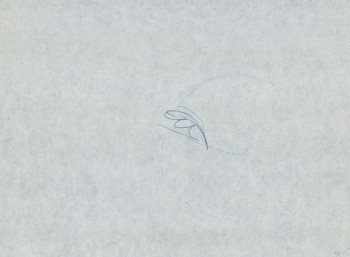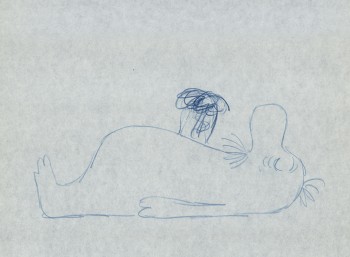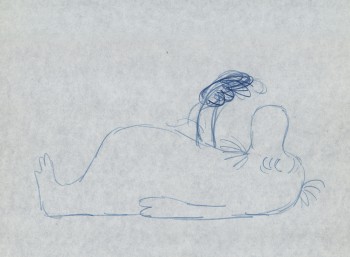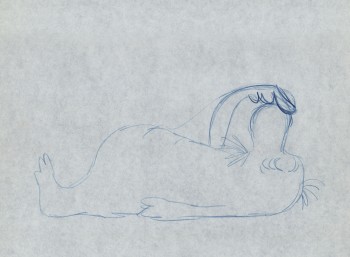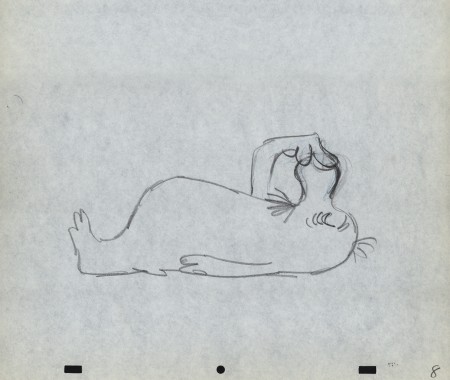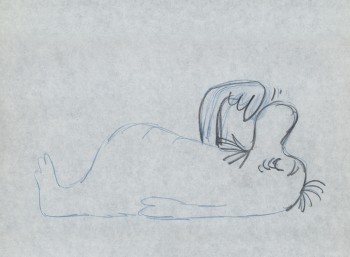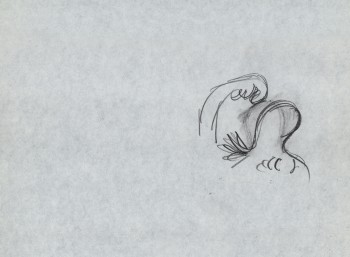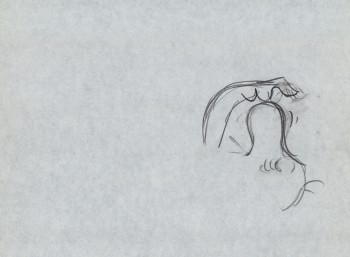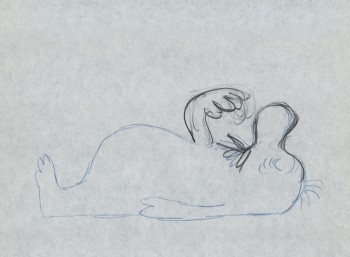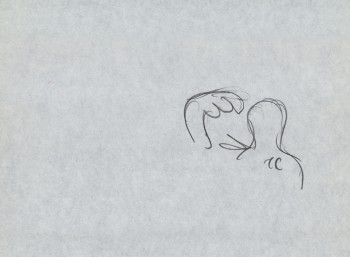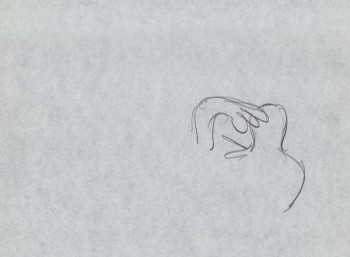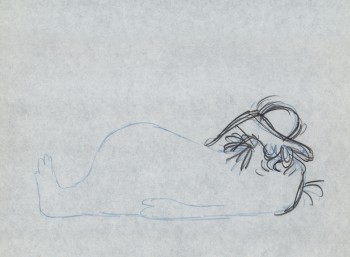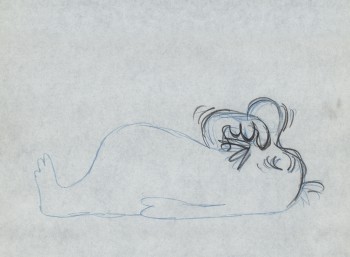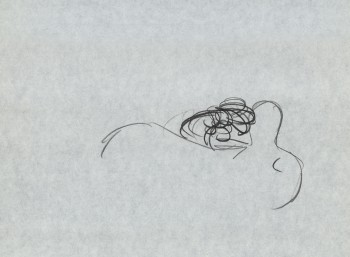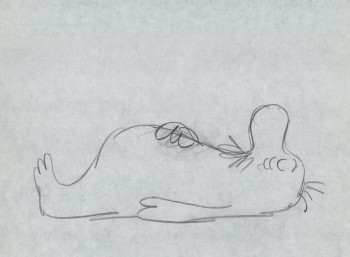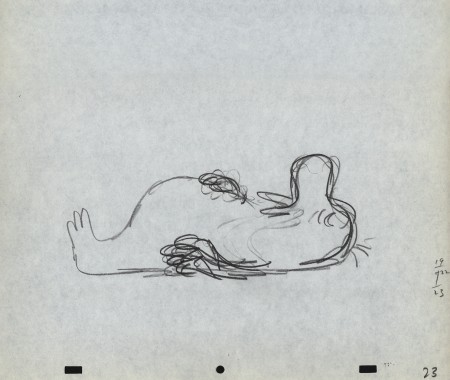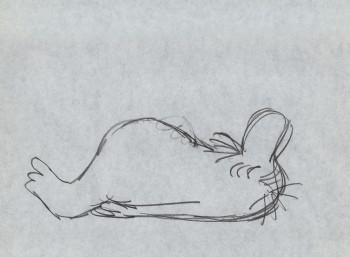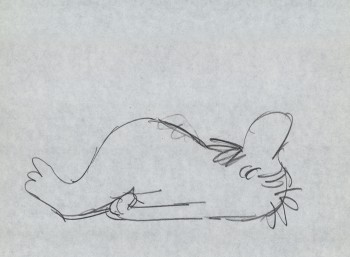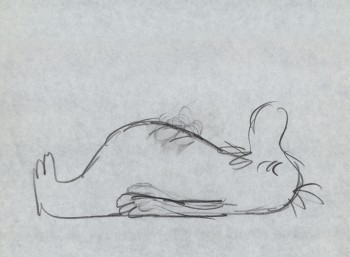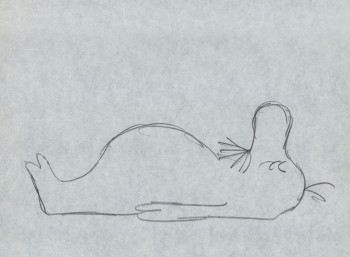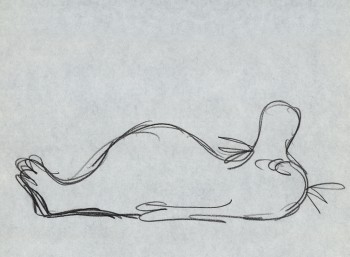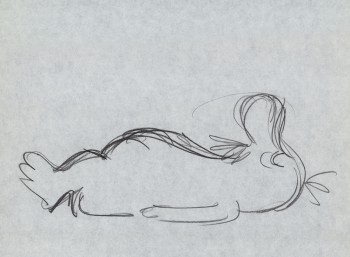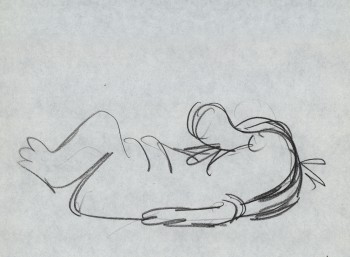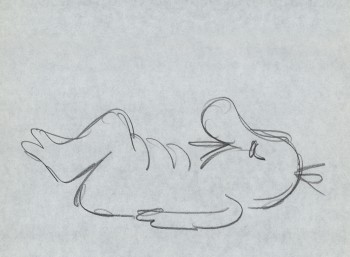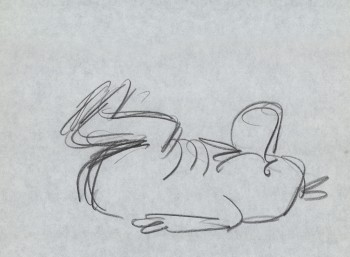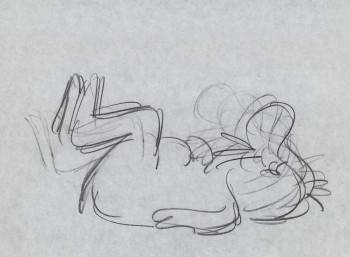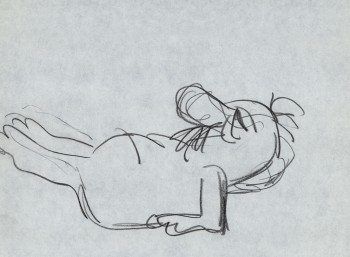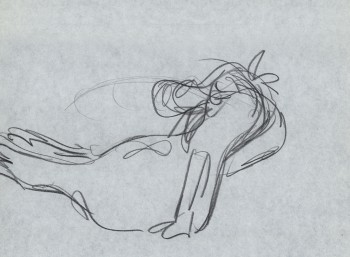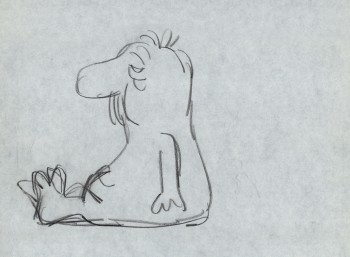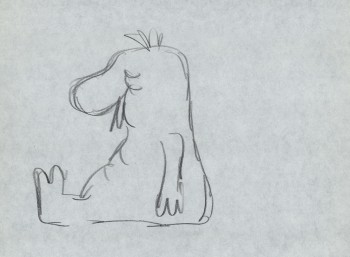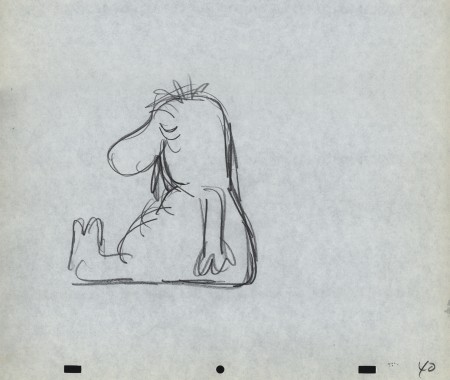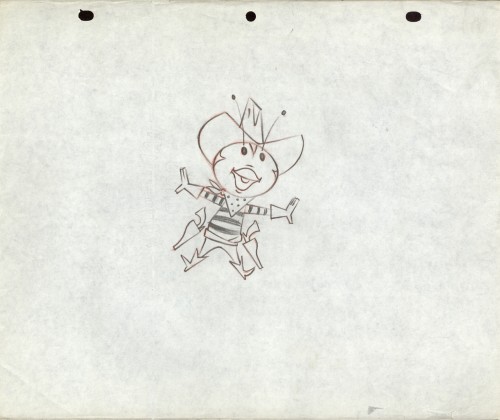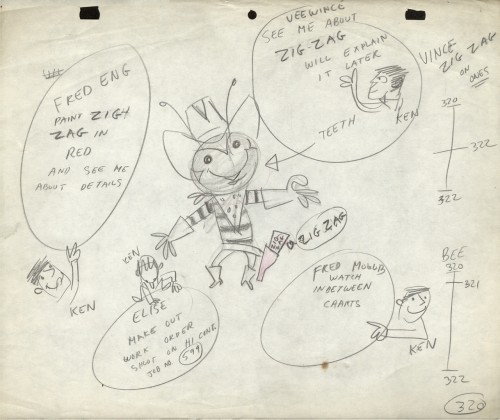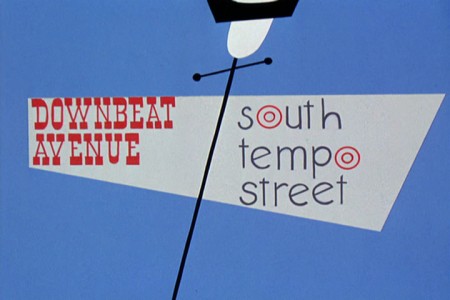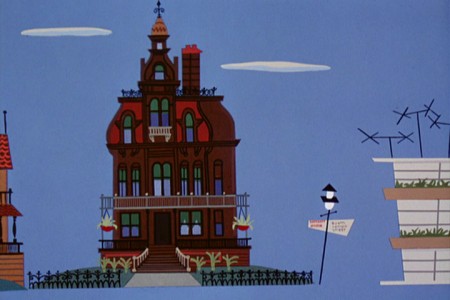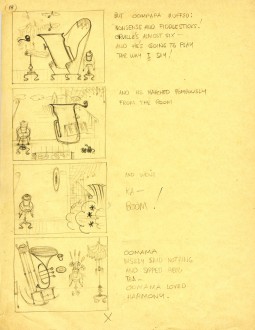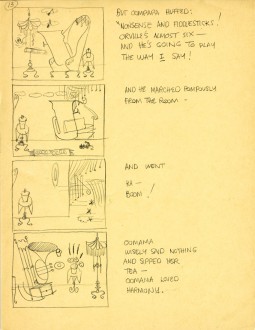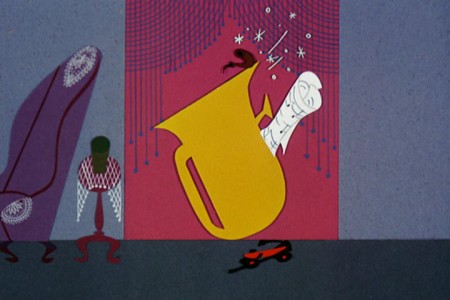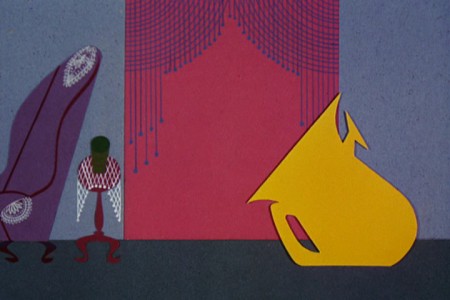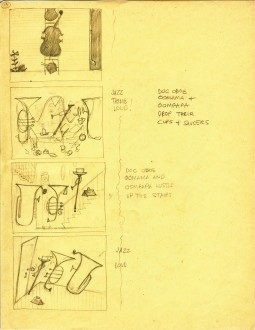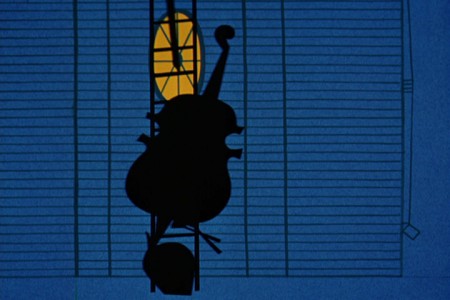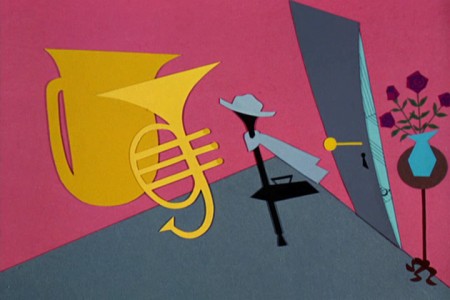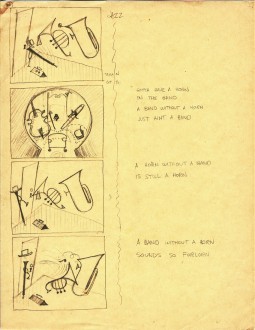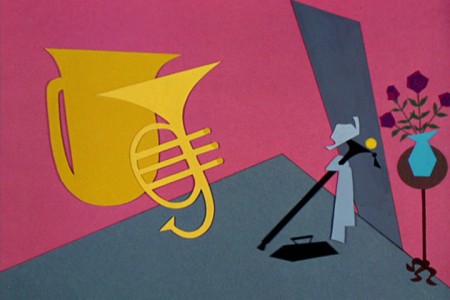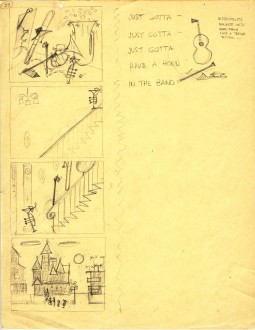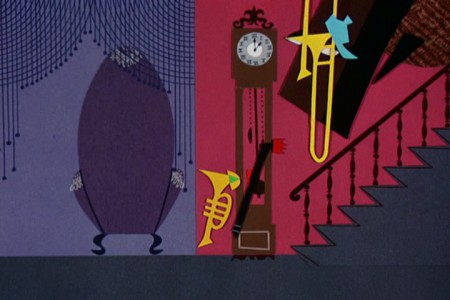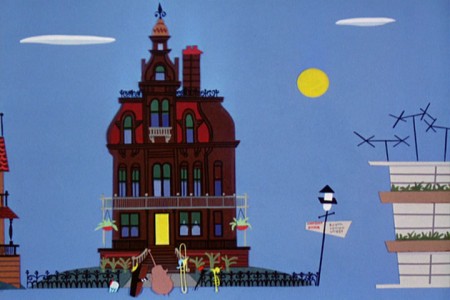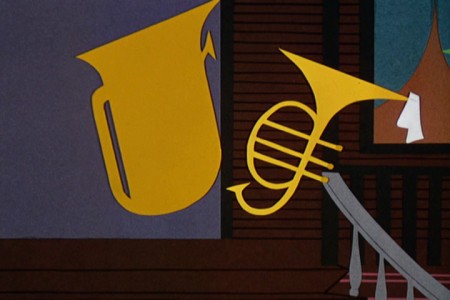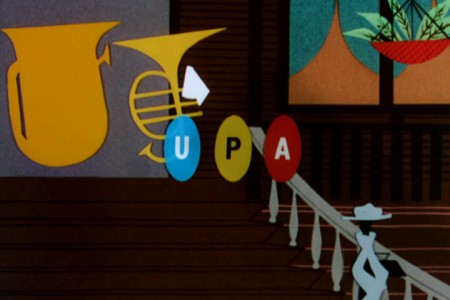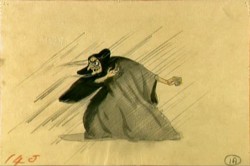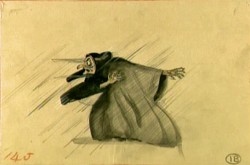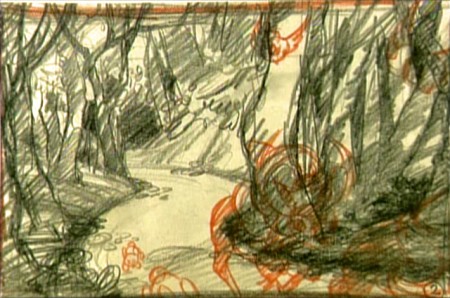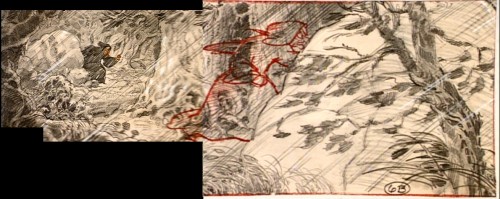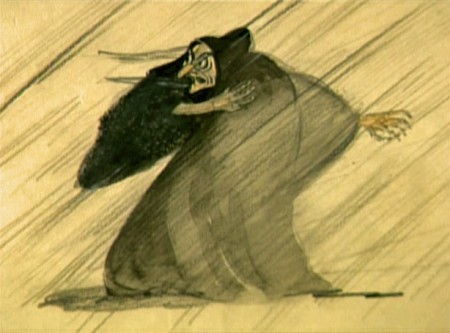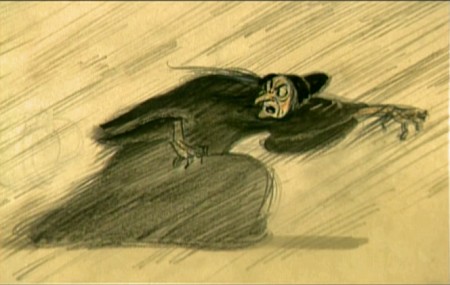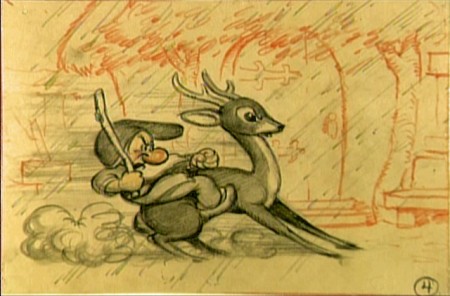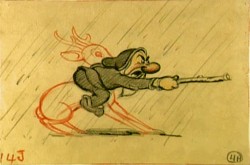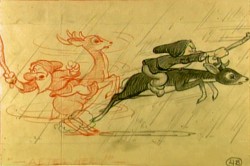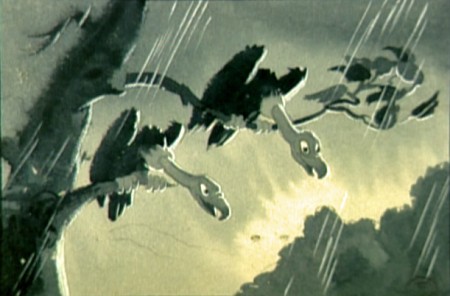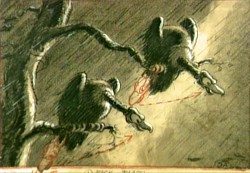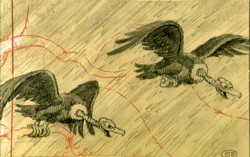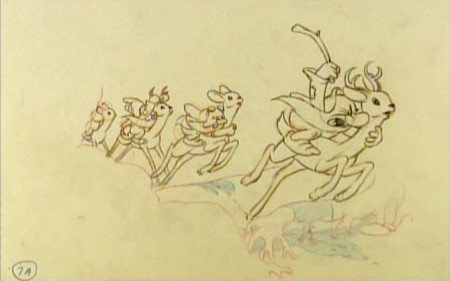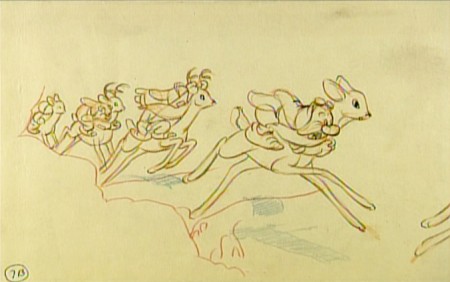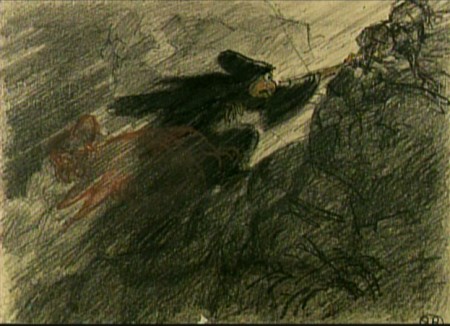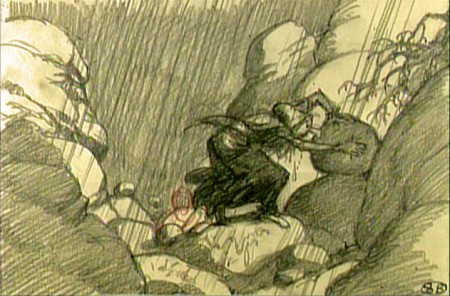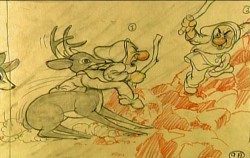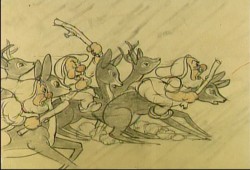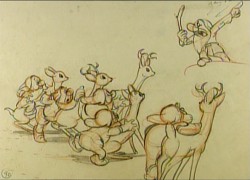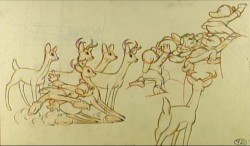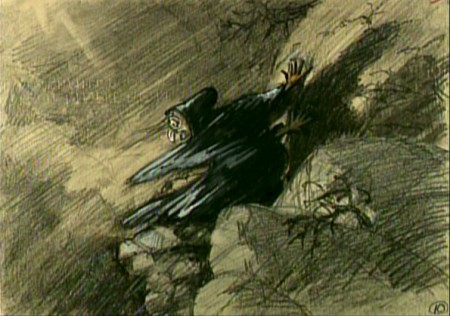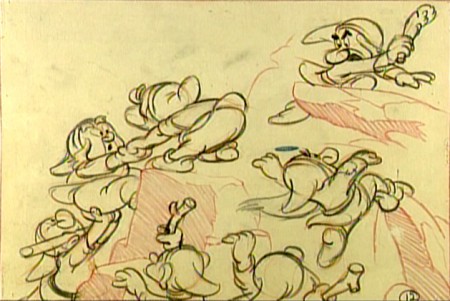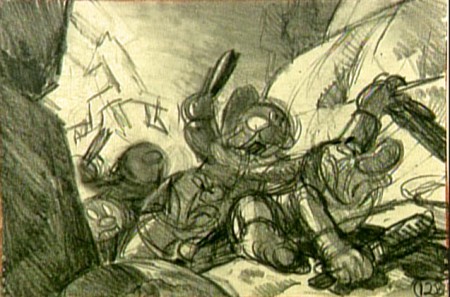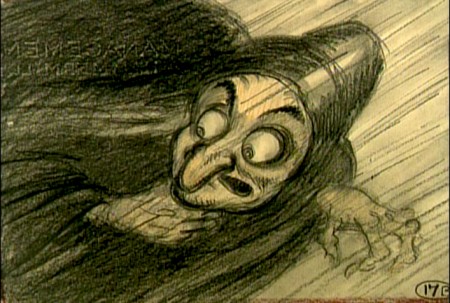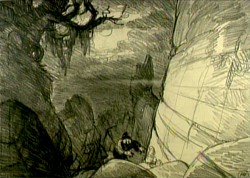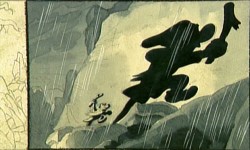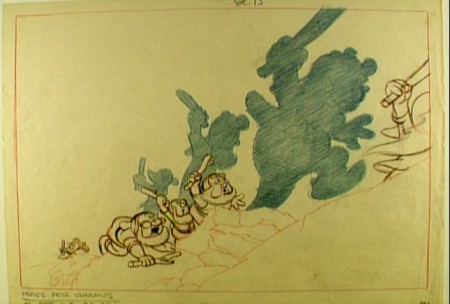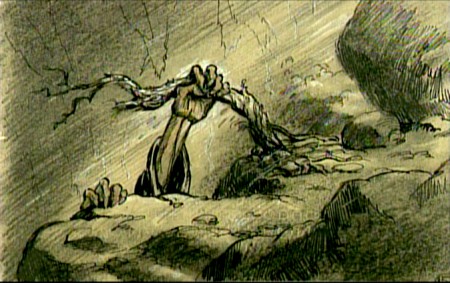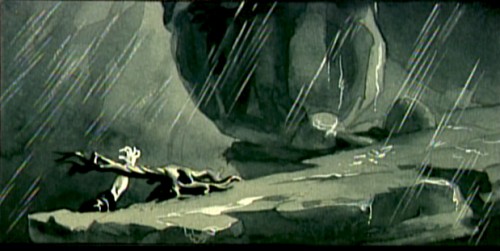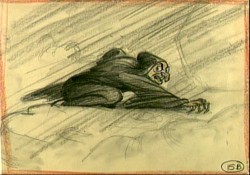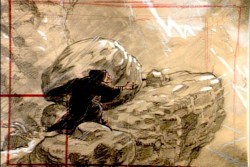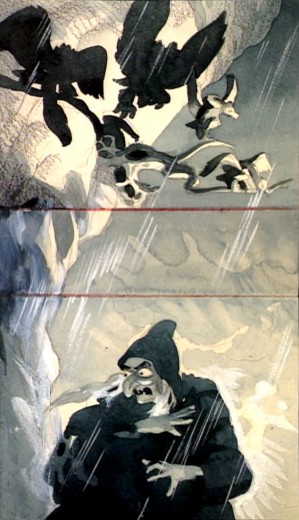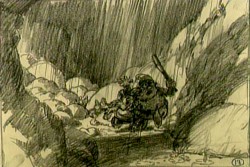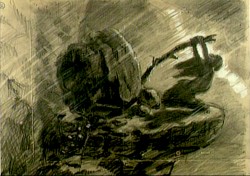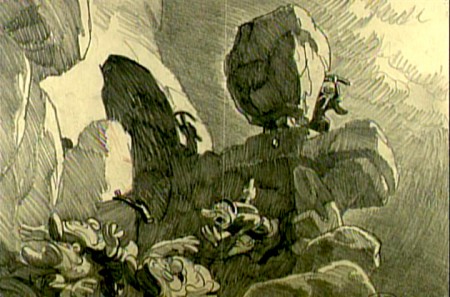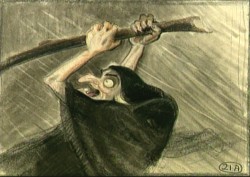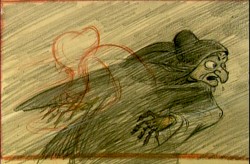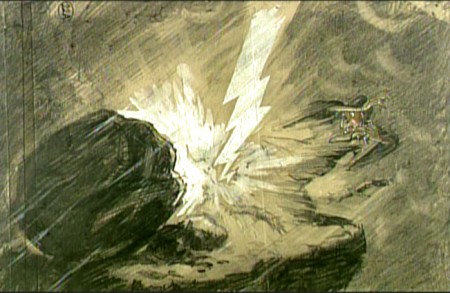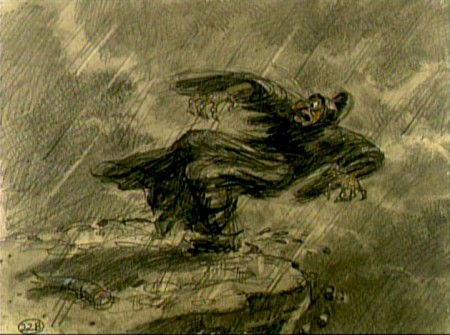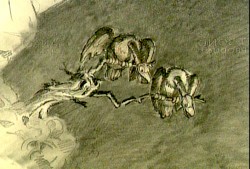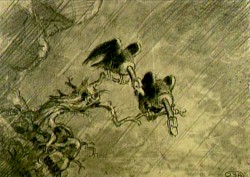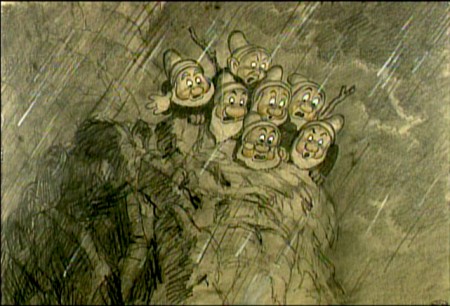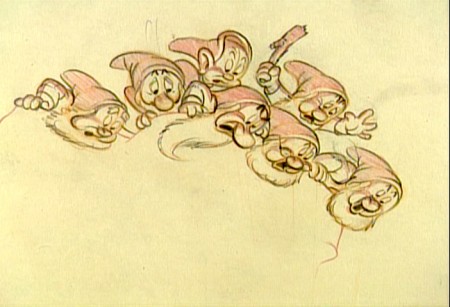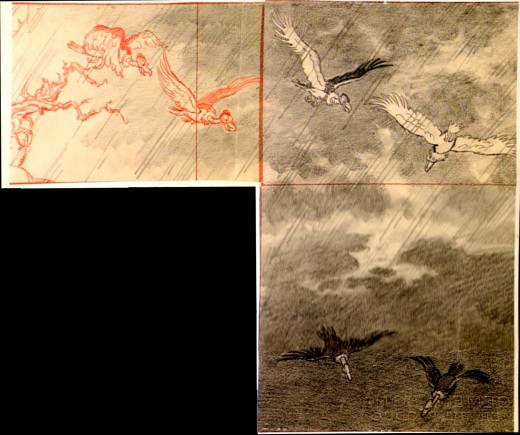Category ArchiveStory & Storyboards
Disney &Peet &Story & Storyboards 21 Feb 2013 06:46 am
Tar Baby – repost
- Back in Oct 2007, I posted Bill Peet‘s excellent storyboard for the Tar Baby sequence from Song of the South.
Given yesterday’s post of color sketches and storyboard drawings from this film, and given that the original posting of these boards was done relatively small, I thought it time to put them up again, but I’ve taken the time to break them down and post them in a slightly larger form, making them a bit more legible.
As with other recent boards loaned me by John Canemaker, I first display them in the original size of the stats as they came to me.
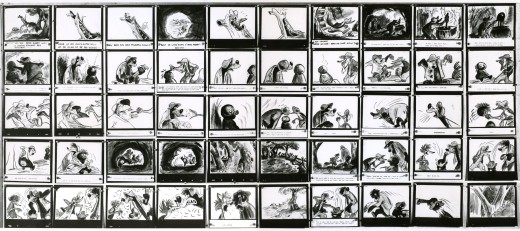 1
1
(Click to enlarge images so you can read them.)
Here is my breakdown of the boards:
 1a
1a
 42a
42a
I just love the drawings from this section.
There are another two pages of the storyboard
which I’ll break down and post tomorrow.
.- Here’s the conclusion to the storyboard by Bill Peet that I began yesterday. It’s the Tar Baby sequence from Song of the South.
I first posted this in October 2007, but I hadn’t broken up the board so that it could be enlarged enough. I’ve done that.
Many thanks go to John Canemaker for initially lending this material for me to post.
.
.
.
This picture comes from the Bill Peet website, worth a visit.
Here are the two remaining original boards:
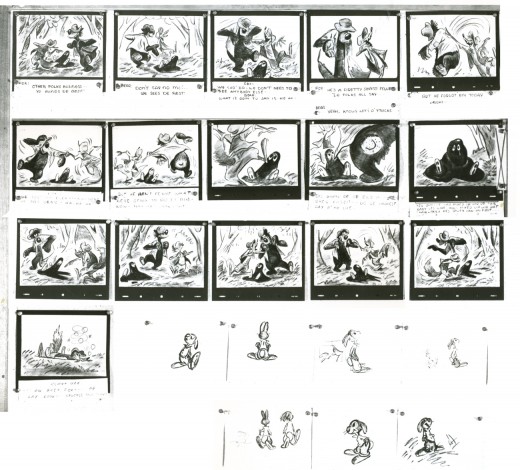 5
5(Click images to enlarge.)
And here are the same two boards broken down by rows:
 51
51
Animation &Animation Artifacts &Bill Peckmann &commercial animation &Illustration &Models &Story & Storyboards 30 Jan 2013 08:26 am
More Misc Commercial Art
- Still left in the Vince Cafarelli collection of drawings from commercials he did, most probably, at Goulding-Elliott-Graham (for the moa part) are the drawings below. We know through some small bits and pieces of information what a couple of the sponsors were. (The wording of dialogue the professor speaks that the sponsor is Nabisco Shredded Wheat; the lion and the mouse ad is obviously for Vicks – drops or vap-o-rub.) However, too many other bits leave us empty handed. I can recognize cartoonist, Lou Myers‘ work anywhere, but no clue what they’re for. Candy Kugel and I were also able to delineate Lu Guarnier‘s drawing style (Vinnie was his assistant for years), and I know Jack Schnerk‘s great work. I recognize the brilliant and great hand of George Cannata from similar work that Bill Peckmann had recognized (see here) in a past post. So it is great to learn as much as we can, even though there’s a lot of guesswork in it.
The following are three storyboard drawings by cartoonist Lou Myers for some spot:
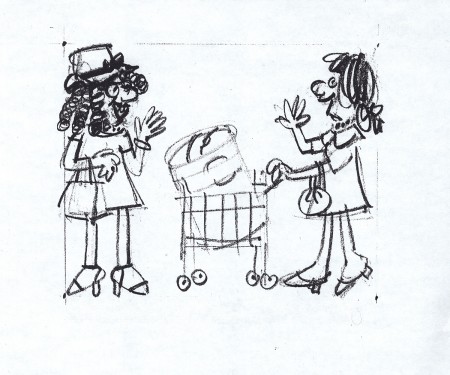 1
1
The following drawings are for Nabisco Shredded Wheat. They’re animation drawings/ruffs by Lu Guarnier. The delicate pencil lines of these years turned into dark rougher ones in his later years. The timing charts were always the same right out early wB years. You’ll notice a lot of quarters and thirds in the breakdowns. This is something you’d never see from Disney. There, everything is broken into halves and halves again and again.
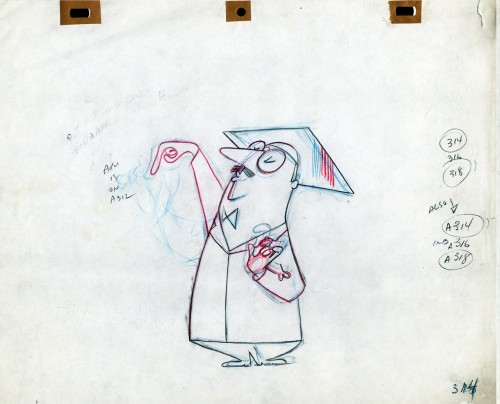 1A
1A
- The following lion is designed and animated for a Vick’s commercial. (Note the second model sheet.) There were quite a few commercials during the period that reworked this great Aesop tale for the sponsor’s use. The lion obviously has a cold. Rather than pulling out the thorn, the mouse introduces him to Vicks’ cough drops and the lion feels a whole lot better.
What has been left behind of this ad includes a couple of model sheets of the lion as well as a couple of animation drawings. I don’t know who the designer is, but the animation drawings are most definitely the work of Jack Schnerk. I suspect all the drawings here are by Jack. He probably kept reworking the model sheet until he got the character in his hand. I can remember him lecturing me on the quality of my drawings. Unless my drawings became roughs, rather than tight clean ups, he was convinced I couldn’t get good animation in my pencil. Jack’s work was rough. and it became much more rough than this, certainly by the time I knew him and was assisting him. He also had a peculiar style of roughness; very choppy angular lines chiseling out the fine drawings. You can get a good example of that with drawing labeled “2D”.
The last four drawings are all animation drawings. “2D” is a rough, “2E” is a clean-up by Jack. The last drawing is a beauty and probably the final look he hit upon.
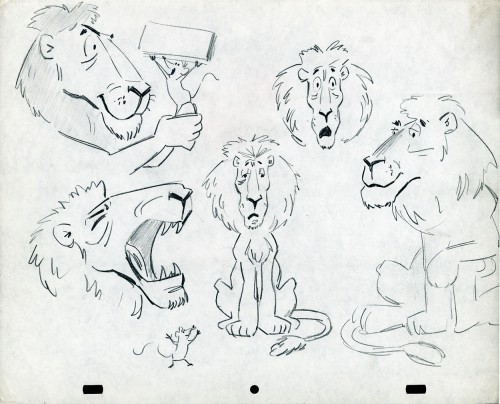 2A
2A
Here we have some drawings by a designer. I suspect that it’s the work of George Cannata. I did a couple of posts on a designer at Robert Lawrence Studio a few weeks back. Bill Peckmann identified the primary designer whose work screamed out to me. Since then, I’d recognize that line anywhere, and it’s most definitely below.
The Groundhog below is obviously a character with a southern drawl. The first step was to try the obvious making him a cowboy (“3A”). But that soon changed. and the character got plenty more sophisticated (“3B & C”). After that the line got juicy and the color got bold. There’s really so much to a character like this who just about animates himself.
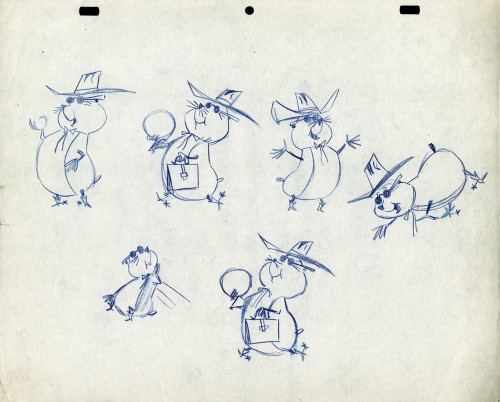 3A
3A
The following five drawings are for a WISK commercial. There are two model drawings and three animation ruffs. The primary model indicates that the spot is done for Screen Gems which was a viable studio in the early 60s and 70s. However, I don’t know who the animator was. Neither Lu Guarnier nor Jack Schnerk fill the bill.I know that Irv Dressler was at Screen gems for many years, but am not sure about this time especially since IMDB has him free lancing for King Features and other entertainment studios. The drawswing style of these animation drawings is right out of the Paramount/Terrytoons mold. Many animators’ work looked like these. People such as Johnny Gentilella, Marty Taras et alworked in a very similar style, though these are a little harder lines than either of those two.
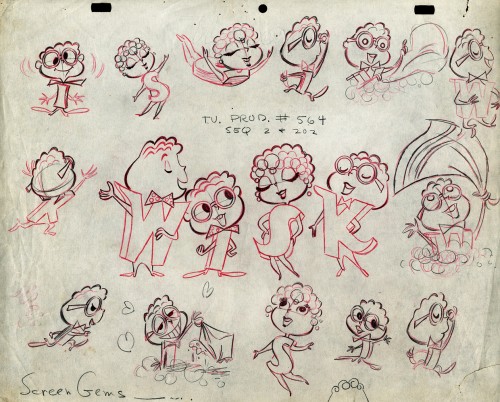 A
AThis is the primary model for the entire family. It’s a
beautiful drawing, and the characters have a lot of play
in them despite being connected so obviously.
Just look at the father’s hair. Beautifully done
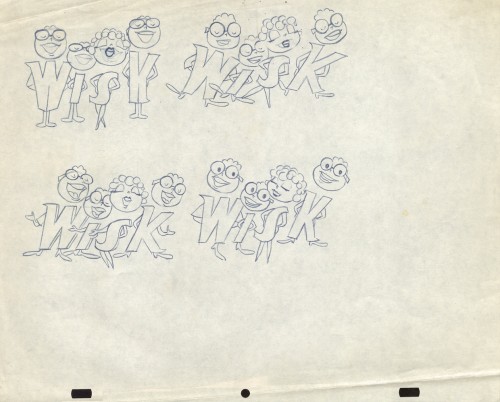 B
B
Here’s a secondary model. I suspect this is the animator
tracing off the characters and seeing what he can do with them.
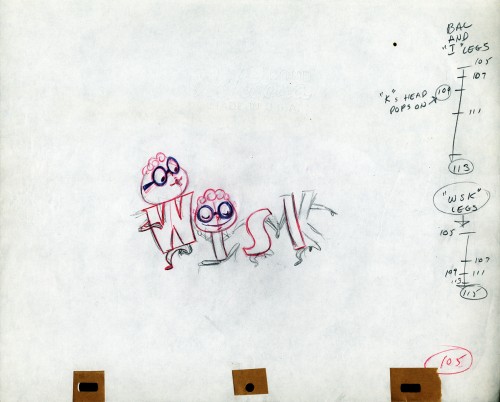 C
C
Animation drawing #105. Those breakdown charts are something.
The Buffalo Bee for Honey Nut Oats is also a model sheet from Screen Gems. With it come an animation model sheet for the walk cycle of the character. These drawings look like Lu Guarnier’s to me, but there’s no official way I could confirm that, of course.
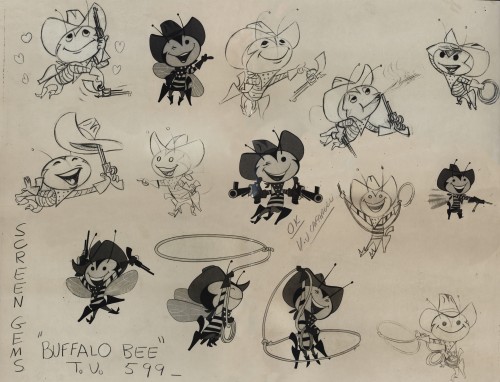
Model sheet
Bill Peckmann &Comic Art &commercial animation &Story & Storyboards &Toth storyboard 24 Jan 2013 07:10 am
Toth’s SuperFriends Storyboard
- Alex Toth did storyboards, too. Here’s one he did for Hanna-Barbera, and it shows the visceral strength of the “SuperFriends” project. More than the original comic book and greater than the final outcome. It’s a class act, and great thanks to Bill Peckmann and Manual Auad who brought it to him. To Bill:
- Many thanks to illustration art publisher, historian, fan extraordinaire, Manuel Auad, we are able to post 28 pages of a Hanna-Barbera “Super Friends” storyboard done by Alex Toth.
Even though the pages are Copies of Copies, they are nice clean copies that haven’t been covered with down-the-line production notes yet.
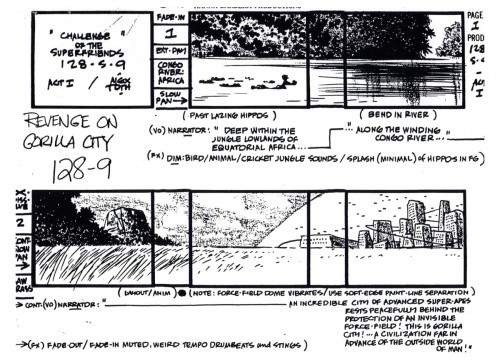 1
1
Here’s another board he did which we posted a while back.
Animation Artifacts &commercial animation &Story & Storyboards 24 Oct 2012 06:13 am
Goulding/Elliott/Graham Storyboards
- Goulding, Elliott, Graham was a company made up of comedians, Ray Goulding and Bob Elliott (“Bob & Ray”) and designer/director, Ed Graham. After the Piels Bros beer account did so well, Bob and Ray realized that they should have a larger piece of the pie, so they set up their own studio to produce commercials that featured their voices and their writing talents. This was an instant success which soon dissipated until the studio closed only two years later.
But they had a nice run. Vincent Cafarelli, obviously, had a good time at the studio (he’d left assisting at UPA to work there). In his collection of animation artifacts, there’s a folder of storyboards for commercials they’d made. I’ve put together a number of these boards and will show them here. I do notice that the writing is interesting (compared to any commercial on the air today) and the design is often exceptional. I hope you agree.
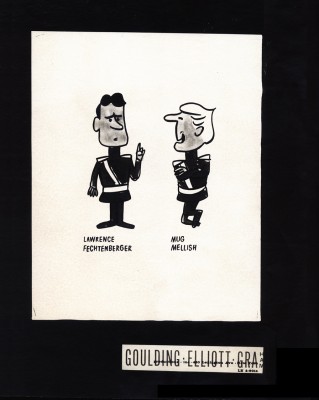
A model of the two characters in this spot.
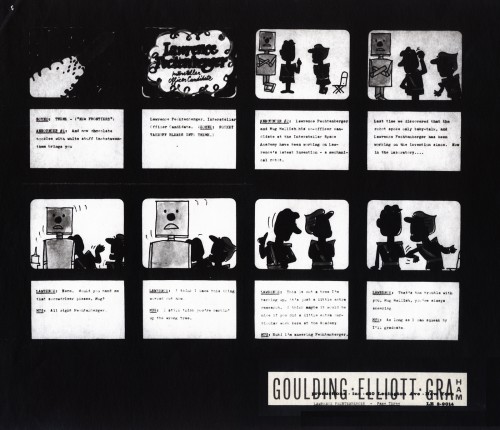 1
1
I can only assume this is an ad for some kind of
“Oreo”- like cookie. The sell is so soft that I can’t
even figure out the client. Doesn’t sound successful.
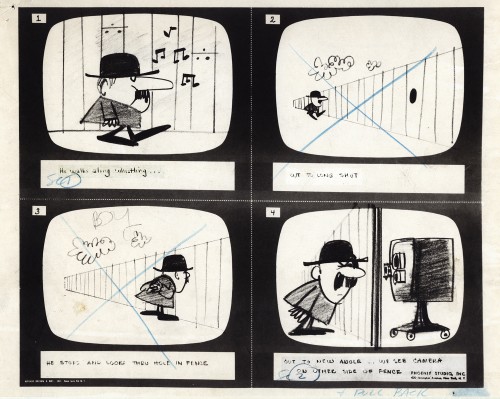 1
1
There’s no doubt that Len Glasser designed this.
It looks just like a character he later did for Ernie Pintoff.
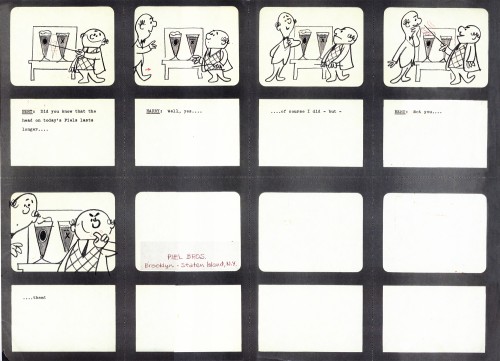
The only spot for Piels, in the collection, is obviously
this short ID – probably 10 secs. long.
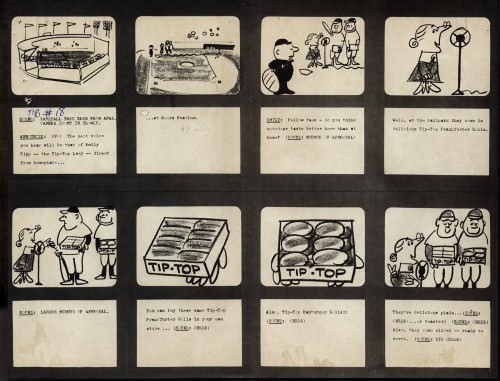 1
1
We’ve seen a number of these Tip-Top Bread spots.
They were certainly a primary client for the company.
These boards were in with the Goulding-Elliott-Graham material,
actually was done at Gifford Studios (Lou Gifford & Paul Kim).
Vince has a lot of these folders in his collection improperly labeled.
Animation &Commentary &Models &Story & Storyboards &Tissa David 22 Oct 2012 05:19 am
The Marzipan Pig Extras
When we completed The Marzipan Pig, the author of the origianl book, Russell Hoban, came to NY from his home in London. He had originally come from Philadelphia to be an art director at an agency in NYC. He eventually moved to England where he became one of our most famous children’s book authors. We arranged a theatrical screening for him of The Marzipan Pig after which Tissa David, he and I went to lunch. In his very dry way, he told me that he was pleased with the film. As I do with all authors, I asked for criticism not compliments, and he told me there was only one complaint. We didn’t get the bridge quite right at the end of the film. Of course he was right, and it’s hard for me to watch those final scenes, now, without thinking about that damned bridge. But he did say he loved the movie, so I held onto that memory as well.
I’ve read every book of Hoban’s I could, including at least 60 of the children’s books and all of his adult novels. In film, I know only of the work we’ve done and The Mouse and His Child. Unfortunately, that feature film stopped midway through the book’s story. It’s a brilliant book and what they did of the story carries whatever is happening on the screen.
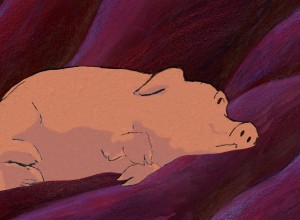 For The Marzipan Pig DVD we included a copy of a section of the animatic. This includes the actual film superimposed over the stills so you can make a comparison as the film runs. Film in film. I like this format; you can really take in the animation and layout of the piece when both are on the split screen.
For The Marzipan Pig DVD we included a copy of a section of the animatic. This includes the actual film superimposed over the stills so you can make a comparison as the film runs. Film in film. I like this format; you can really take in the animation and layout of the piece when both are on the split screen.
I thought I’d post here some of the storyboards and the animatic for that section. Of course, this is in a low res version; more can be discovered in the dvd version.
Tissa David did the storyboard and animated the entire film by herself. This film is a beauty, if I do say so myself. It’s a truly adult film, though it was sold as a family film. It deals with love in all its forms, albeit, obviously, through metaphor. It was adapted from a brilliant children’s book; one of Russell Hoban‘s finest.
Quentin Blake illustrated the original book, and we didn’t purchase the illustrations. Hoban told us that it wasn’t how he’d imagined the pig to look, so he drew it for us. He was once an art director in an ad agency, so he was able to draw. This is the pig we used.
Hoban had hated what was done with his book, The Mouse and His Child, so demanded that all the spoken dialogue in the film be found among his words. We wrote a script; Maxine Fisher went to London to work with him in revising it. Finally, when it came to recording the actor Tim Curry, I threw out the script and had him read the book – with the exception of one line. It was a good decision, and it made for a great performance from a great actor.
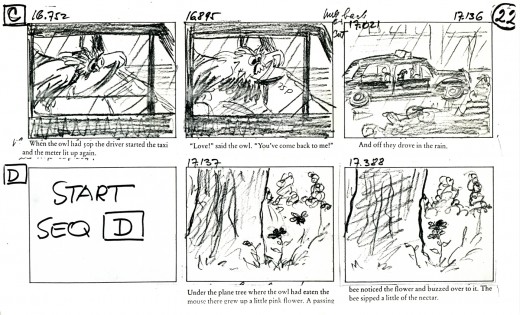
_____________(Click any image to enlarge.)
You’ll notice that some changes were made
in scenes and scene cuts as the animation progressed.
This is typical.
Here are two films we did for a home video of children’s poems. The first is a poem by Russell Hoban. The animation is by Mark Mayerson, and the design is by Jason McDonald. The music is by Caleb Sampson. I think all of these artists did brilliant work, but then Hoban’s thoughts and words always pull out the best.
Russell Hoban’s The Tin Frog
This second poem of Hoban’s also brought out the best in the artists, Jason McDonald who designed and storyboarded the whole piece. The excellent animation was by Sue Perrotto..
Russell Hoban’s Jigsaw Puzzle
Click left side of the black bar to play.
Right side to watch single frame.
Bill Peckmann &Story & Storyboards 28 Sep 2012 05:54 am
Toth H&B storyboard
Alex Toth worked at Hanna Barbera in their story department. Bill Peckmann told me he had some boards from Toth’s stay there, and I asked him to send them on. The board presented here is far from complete. It’s missing many pages and whole segments. But the images, as might be expected are terrific. So look for the drawing and forget the storytelling.
Here are some comments from Bill:
- I’ve come across some Toth storyboards (copies) from his Hanna-Barbera days. One incomplete set is really neat. This is a live action board that Alex did for Hanna-Barbera in 1978. Unfortunately all we have are these Xeroxed 28 random panels from the original board. (I wonder if that still exists anywhere?) At least it gives us a rare peek at how Alex handled a live action film assignment instead of his H-B Saturday morning cartoon fare. With this sparse sampling of pages, the continuity will not make much sense but the individual panels are a pleasure to look at.
The title of movie that Alex did this live action storyboard for, it’s a 1979 film called “C.H.O.M.P.S.”
Here is it’s listing in HALLIWELL’S FILM GUIDE.
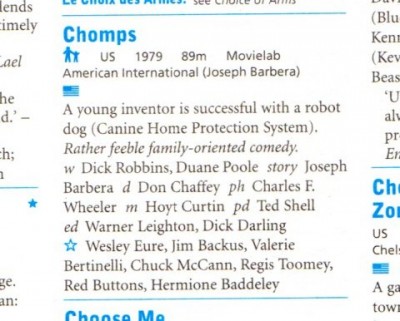
.
And here is the board:
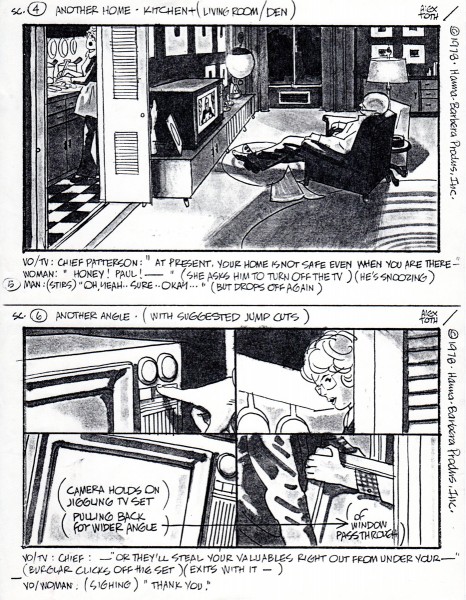 1
1
Animation &Animation Artifacts &commercial animation &Models &Story & Storyboards 12 Sep 2012 07:00 am
Sleeper – Vince Cafarelli collection
- Today I stumbled upon an odd spot in the collection of artwork saved by Vince Cafarelli. This is the storyboard and rough animation for a piece that Vince animated to a storyboard by Hal Silvermintz. The two worked on this when they were employed at Stars & Stripes Productions Forever, Inc.. It was something that the two were obviously doing for themselves – (an Independent film?). In any case it never seemed to have gone farther than this animation. . . at least, not in this form.
“Weekend” was a weekly news show that included a short animated piece. Perpetual Motion Studio did these weekly animation pieces for the NBC show airing on late night Saturday night. (This was before Saturday Night Live aired.) The budget was almost nil, so the material had to be not too expensive and the work had to be fun.
During the run of this series of shorts, Hal Silvermintz pulled out the storyboard, and it moved ahead in a new version. Candy Kugel animated the “Weekend” version and finished it for Ink & Pt. The final color spot aired in 1973-74.
Here’s the storyboard and a model sheet:
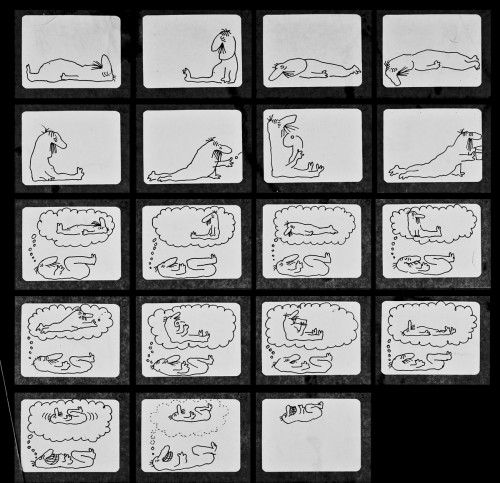
The original storyboard.
Here are drawings from about half of the first scene. For four key positions, I’m posting the entire page, pegs and all. For the remainder of the drawings, I just have the character for you.
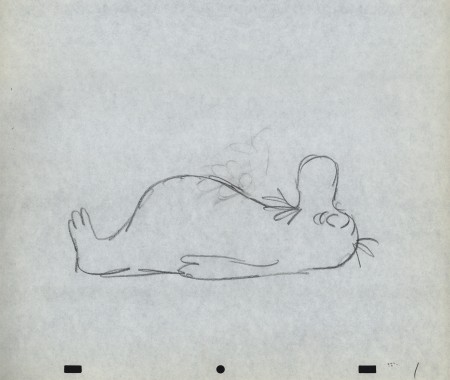 1
1
Here’s a QT movie of the drawings posted above.
There were no X-sheets to offer timings, so I had to
guess at the timings that might have been used.
Animation &Animation Artifacts &commercial animation &Layout & Design &Models &Story & Storyboards 08 Aug 2012 07:00 am
Vince Cafarelli Grabbag
- Today we have a mix of odds and ends from Vince Cafarelli’s collection of animation artwork. We start with some artwork from the commercial studio in NY in the 1950s-60s.
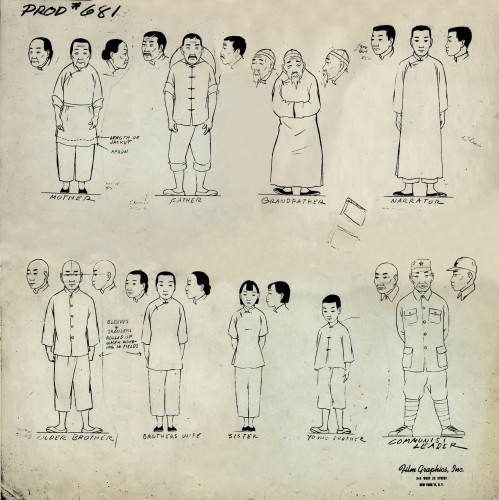 1
1This is a model sheet for something done
at Film Graphics. No doubt it’s not a commercial
but probably some kind of Educational film.
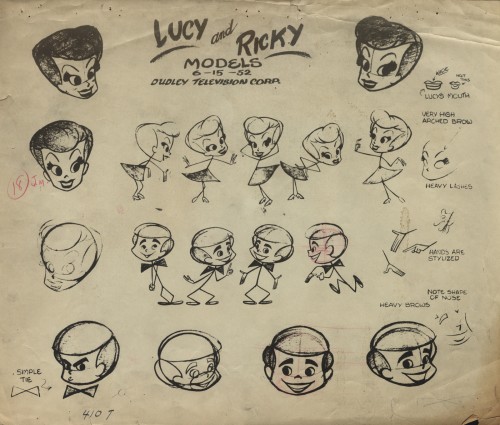 2
2
This is a model sheet for the opening titles to
the “I Love Lucy” show. My guess is that
this also comes from Film Graphics.
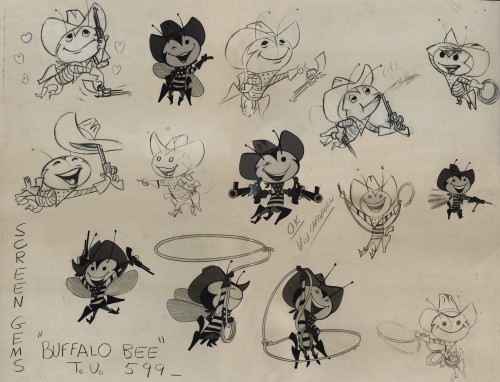 3
3
The Buffalo Bee model sheet for the Nabisco
Wheat Honeys commercials. Mae Questel was the voice.
This was probably done for the Gifford Studio.
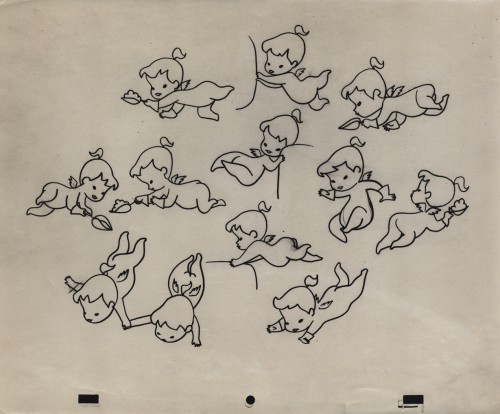 6
6
A model for a little angel. I assume this is for a
paper product commercial. Again, I think it’s the Gifford Studio
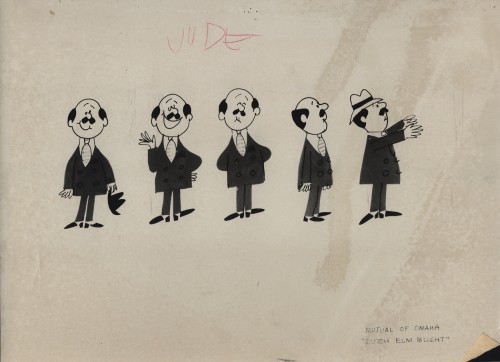 7
7
A turn-around model for a Mutual of Omaha commercial.
Again, since it’s with other Gifford Studio material I’d guess the same.
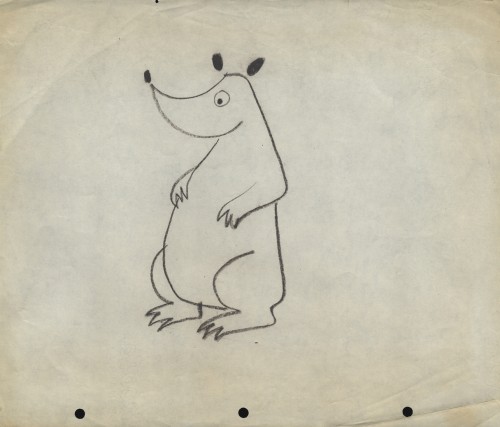 8
8
Here are two bear drawings from some commercial.
It looks like Dick Williams’ Cresta Bear (only this was
done years before that.)
 9
9
The three round peg holes is certainly unique.
Fleischer used a similar system for a wile as did
Krantz Studio on Fritz the Cat.
I don’t know where these are from.
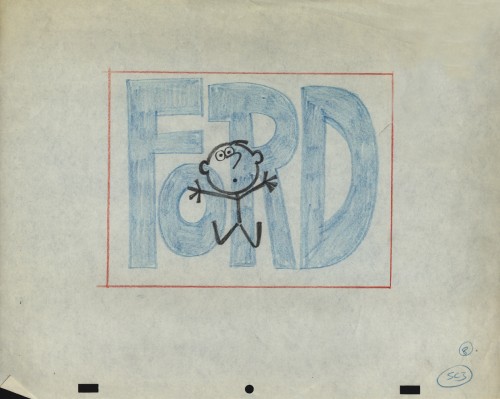 10
10
I’m sure this comes from the Gifford Studio.
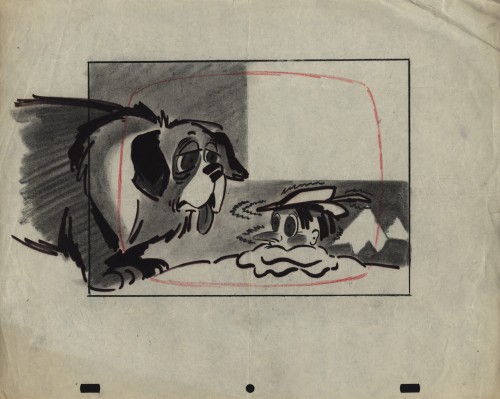 11
11
An interesting design. I assume it’s from a spot.
Peg holes look like the Gifford Studio.
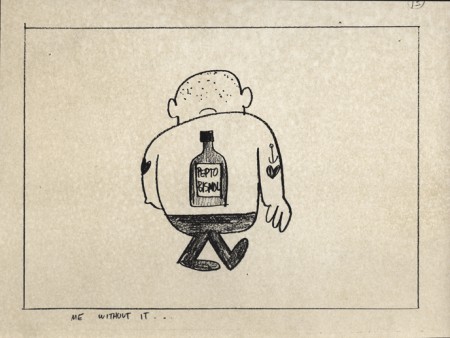 12
12
A storyboard drawing for a Pepto Bismol commercial.
UPA had this account for a long time.
The following three drawings are two animator’s drawings (#106 & 108) and one Inbetween (#107). I believe the animator is Frank Endres; the inbetweener is Vince Cafarelli. For some reason I think this is from a Little Lulu cartoon directed by Bill Tytla, but I can’t vouch for that. I’m sure one of you visitors will let me know how wrong I am, and I welcome it.
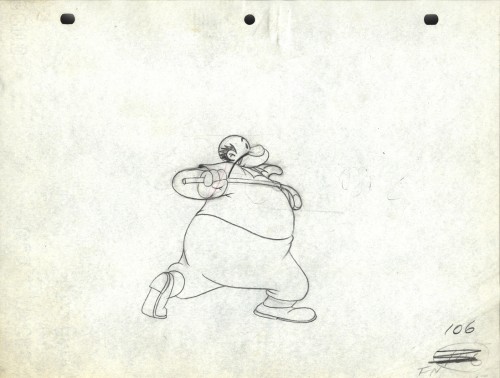
Drawing # 106 – animator’s drawing
I’m surprised at how small the paper is; not quite 8½ x 11.
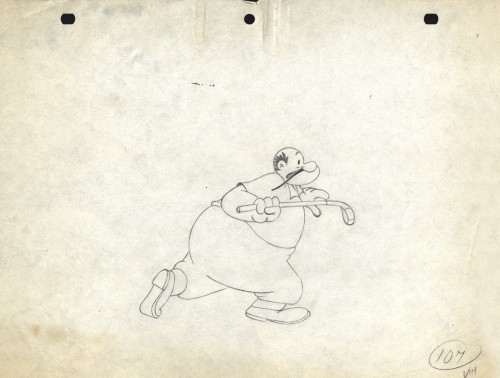
Drawing # 107 – inbetweener’s drawing
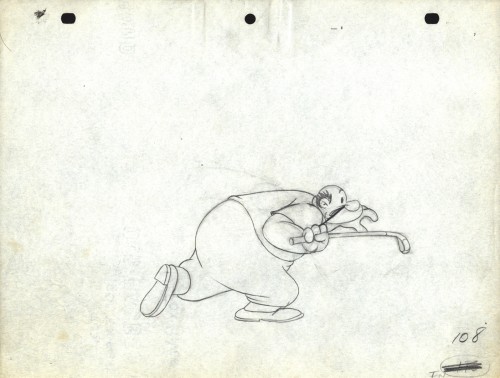
Drawing # 108 – animator’s drawing
The peg holes are Signal Corps.
Animation Artifacts &Frame Grabs &Story & Storyboards 23 Jul 2012 04:33 am
Oom Pahs
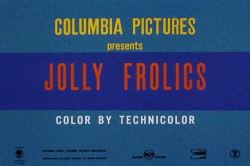
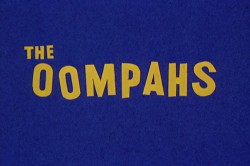
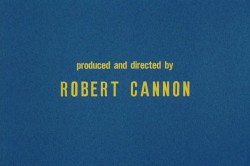 - I’m a fan of T.Hee‘s work. I bought the storyboard he did for the film The Oom Pahs a while back. How could I go wrong since I also love UPA and Bobe Cannon, who directed it. This was the first collaboration between T.Hee and Bobe Cannon.
- I’m a fan of T.Hee‘s work. I bought the storyboard he did for the film The Oom Pahs a while back. How could I go wrong since I also love UPA and Bobe Cannon, who directed it. This was the first collaboration between T.Hee and Bobe Cannon.
The short was a 1952 UPA film directed by Bobe Cannon. The film’s music score was by Ray Sherman who worked with Ben Pollack’s group, the “Pick-a-rib Boys.”
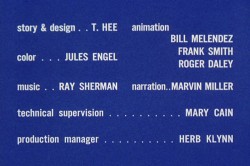 T. Hee boarded and designed the film with Jules Engel doing the bgs, and the animation was by Roger Daley, Bill Melendez and Frank Smith.
T. Hee boarded and designed the film with Jules Engel doing the bgs, and the animation was by Roger Daley, Bill Melendez and Frank Smith.
The film isn’t one of the best UPA shorts. I find the style interesting (cut out colored construction paper) but the story (which to me seems to be a variation of Warner’s I Love To Singa, which was a take on Jolson’s Jazz Singer) is a jazz vs classical music riff. The film talks down to its audience a bit – a frequent problem with many of the UPA films.
The pages I have obviously are not the whole thing nor are they consecutive in number, but they’re a good sampling.
Here are those board pages intergrated with frame grabs from the same sections of the film so you can see how closely the cutout animation followed T.Hee’s board.
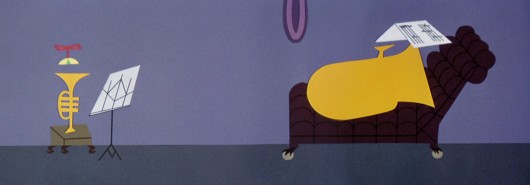
The story tells of a young trumpet in a family of horns.
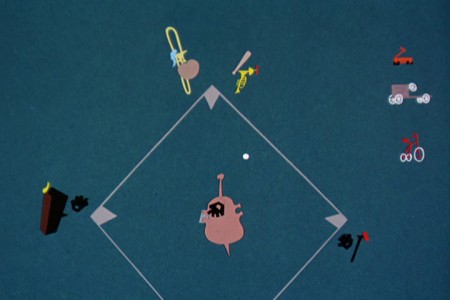
He gets in trouble playing baseball (jazz) when he should be . . .
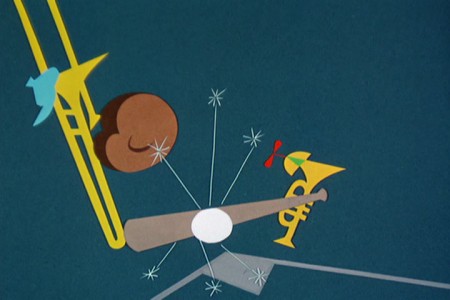
. . . practicing his classical music lessons.
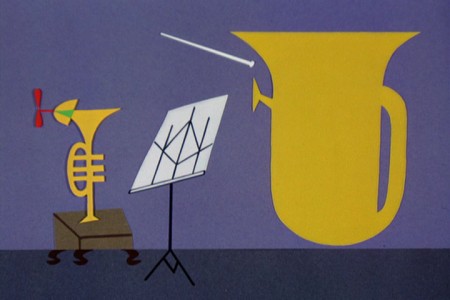
“… And he’s going to play the way I say!”
There’s no doubt the cutouts are pasted to cels.
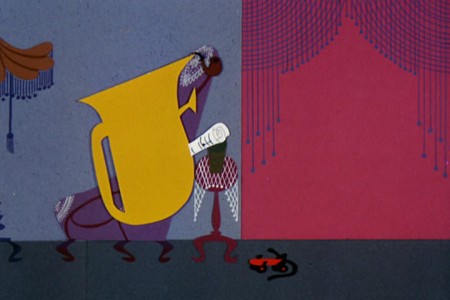
“And he marched pompously from the room.”
The animation repeats itself exactly, and it could not
have been animated under the camera, on the fly.
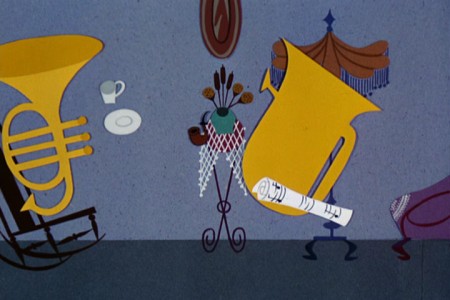
“OomMama wisely said nothing
and sipped her tea.”
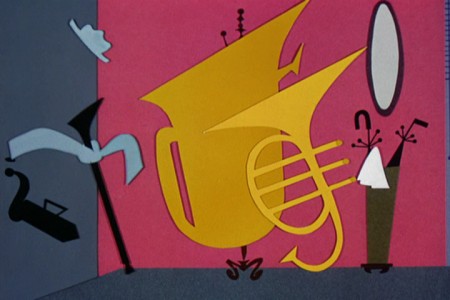
“Doc, OomMama and OomPapa drop their cups and saucers . . . ”
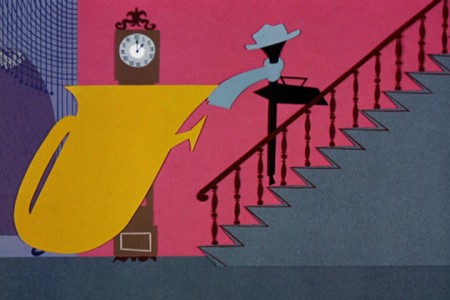
“. . . and hustle up the stairs.”
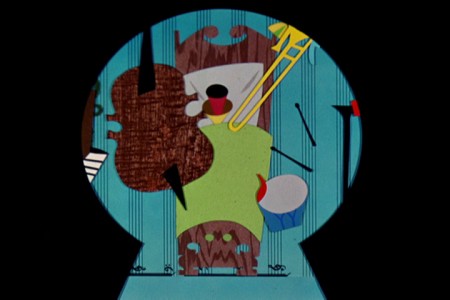
“A band without a horn just ain’t a band.”
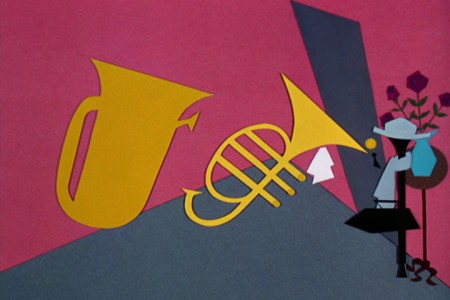
“A horn without a band is still a horn.”
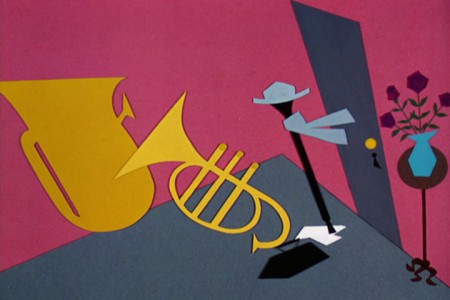
“A band without a horn sounds so forlorn.”
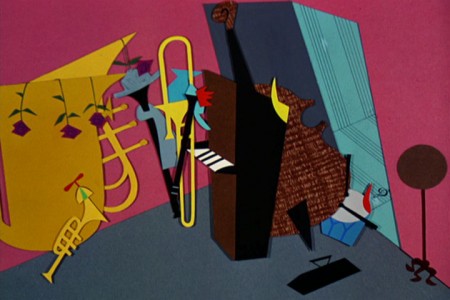
“Just gotta, just gotta, just gotta . . . ”
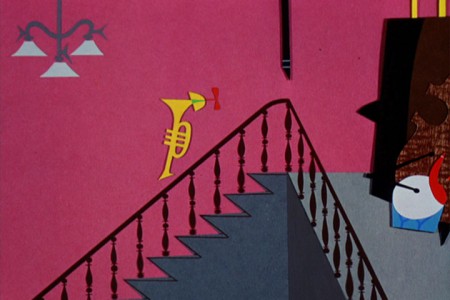
“. . . have a horn in the band.”
To see a couple of layout drawings for this short, from Hans Walther‘s collection, go to site here and here.
Disney &Frame Grabs &Models &Story & Storyboards 16 Jul 2012 05:00 am
Witch – recap
With all the reworked versions of Snow White in Live Action that are currently bombing at the box office, Disney cancelled another one that was in production. The Order Of The Seven had Soairse Ronan cast as the Snow White-like character. The story took place in Asia and had samurais.It’s not happening anymore. This is a good time to take a look at a great sequence from the wonderful original version. I originally posted this in January, 2009.
- It’s not always easy to kill a witch. This sequence from Snow White couldn’t be designed better. It’s short, it’s tense, it’s a tight sequence that handily does its job. The witch is killed in record time. Today, the sequence would be dragged out for half the length of the film.
Some of these drawings are great.
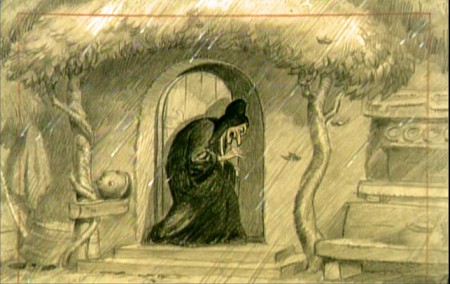 1
1(Click any image to enlarge.)
Hans Bacher continues with his beautiful background recreations, posting a number of clean backgrounds from Snow White, yesterday, on his blog. These are gorgeous and deserve your attention.
